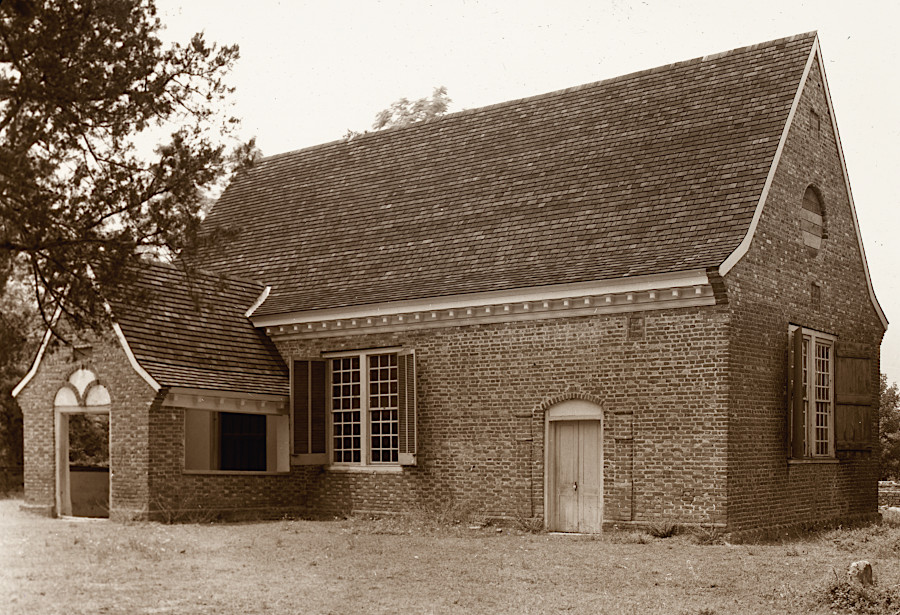
building Yeocomico Church with brick rather than less-expensive wood demonstrated permanence and authority of the Church of England
Source: Library of Congress, Yeocomico Church, Cople Parish, Hague vicinity, Westmoreland County, Virginia

building Yeocomico Church with brick rather than less-expensive wood demonstrated permanence and authority of the Church of England
Source: Library of Congress, Yeocomico Church, Cople Parish, Hague vicinity, Westmoreland County, Virginia
In the 1500's, Kings and Queens in England sought to force subjects to follow their personal perspectives on religion, especially how religion confers authority on rulers. Henry VIII declared that he, rather than the Pope who led the Roman Catholic church from Rome, had the top authority over religious theology and doctrine to be practiced in England.
In the 1534 Act of Supremacy, Henry VIII had Parliament define the King as the head of the Church of England. Using that authority, Henry VIII later confiscated the lands and wealth of the monasteries which had controlled 20% of England's cultivated land.
Henry personally had been raised as a Catholic, and he was comfortable with those beliefs and rituals. His dispute with the Pope revolved around his desire to divorce his first wife and the Pope's refusal to authorize the divorce. Henry VIII did not accept salvation by faith alone, as espoused by Martin Luther. Henry VIII became the leader of a Church of England that was, organizationally, separate from the Roman Catholic church, but Henry VIII still retained traditional Catholic doctrine for controversial issues such as transubstantiation and clerical celibacy.
In contrast, his son Edward VI was raised as a Protestant - and who would follow him was a problem for the Protestant leaders in England. His half-sister Mary had ben designated in Henry VIII's will as next in line to inherit the throne after Edward VI. However, Mary was a Catholic. Her mother, Henry VII's first wife, was Catherine of Aragon - daughter of the King of Spain, and a strong supporter of the Pope's authority.
Edward sought to change the line of succession. He wanted to have a Protestant cousin replace him, but that effort failed. Lady Jane Grey was quickly displaced after Edward VI died and his half-sister Mary took the throne.
Queen Mary re-established Roman Catholicism as the state religion, and enforced that decision. She became known as "Bloody Mary" for the execution of people whom she categorized as heretics, including 300 people burned at the stake. In the 1500's, religious uniformity was equivalent to political uniformity. Religious dissenters were perceived as a threat to the ruler's control.
In 1554, Queen Mary married the man who became King Philip II of Spain. That marriage could have led to a partnership with Spain regarding the religious wars in Europe, with England intervening on the Catholic side. In international relationships, the religion of the rulers was a significant factor in determining friend vs. foe.
Mary died childless in 1558, and her half-sister Elizabeth succeeded her. Elizabeth I was a Protestant, and Spain sought to gain control over England by a military conquest. The defeat of the Spanish Armada in 1588 reduced the threat, but England's political leaders still viewed Catholics as potential traitors.
One threat was Mary Queen of Scots, a descendant of Henry VII of England. She was the only legitimate heir of King James V of Scotland, and Henry VIII had tried to force a marriage between her and his son Edward. Despite a war with Scotland called the "rough wooing," her father sent her to Catholic France. There she married the prince. He died before becoming king, so she returned to Scotland. She became Queen Mary, was imprisoned by the Protestant nobles, and escaped to England in 1568.
Though kept under house arrest or imprisoned while in England, she conspired with other Catholics to seize power from Queen Elizabeth I. After enough evidence was collected to prove her guilt, Protestant Queen Elizabeth order the execution of Catholic Queen Mary in 1587.
Elizabeth I, the "Virgin Queen," also died childless in 1603. Her successor was James VI of Scotland, the son of Mary Queen of Scots. He had been baptized as a Catholic, then raised a Protestant, and eventually married a Catholic.1
James I was inclined to tolerate openly the different religious practices of both Protestants and Catholics. He authorized a new translation of the Bible for better understanding of it by those who could read, a translation which became the King James's Version. James' tolerance cooled after the 1605 Gunpowder Plot was foiled. Guy Fawkes and other Roman Catholic conspirators failed in their plan to blow up Parliament, and the Catholic threat created a greater focus on religious conformity in order to minimize political dissent.2
The restrictive approach of James I was demonstrated in 1606, when venture capitalists sought royal authority to establish a colony in the New World. His First Charter, issued April 10, 1606, did not require religious conformity. However, on November James I issued Articles, Institutions and Orders that required the London Company to establish the Church of England as the one true faith in the new colony:3
In its first meeting in 1619, the General Assembly formalized the establishment of the Church of England, also known as the Anglican Church, as the only authorized religion in the colony. The Church of England became the official ("established") government-protected religion of Virginia in 1619. The burgesses in 1619 passed a law requiring that:4
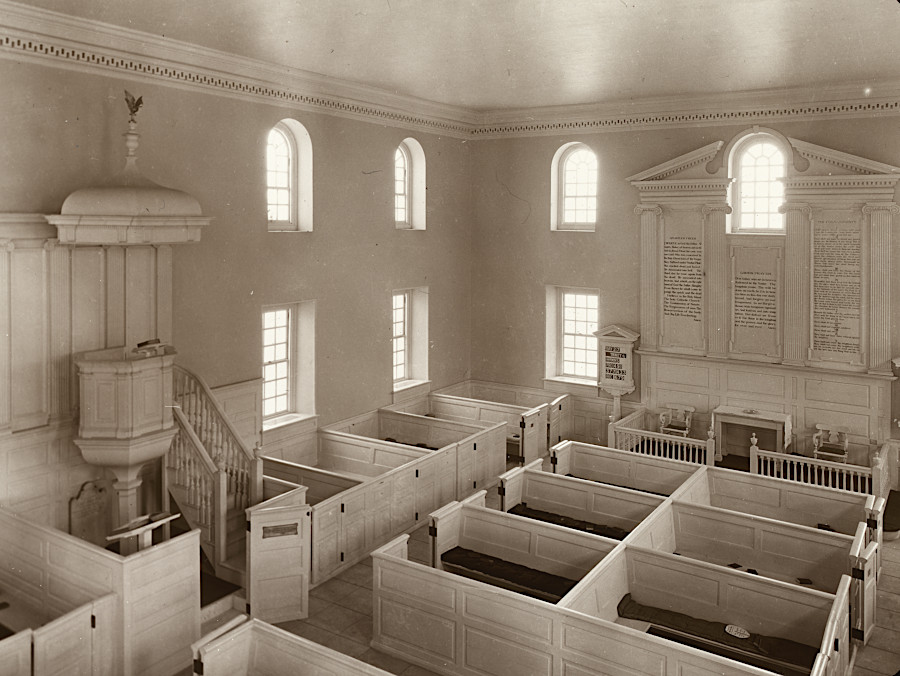
in the colonial period, ministers in Anglican churches spoke down to parishioners who sat in pews ranked by social status
Source: Library of Congress, Pohick Episcopal Church, Lorton vicinity, Fairfax County, Virginia. Interior
England was not a theocracy where the church controlled the government. It was the reverse, where the government controlled the church and appointed the bishops. In Europe, there were constant challenges regarding the temporal authority of the Pope in Rome vs. the power of monarchs in separate nations.
The Catholic kings in Spain tried to force neighboring countries with Protestant rulers to become Catholic and acknowledge the Pope's authority. Those religious wars may have been based in part of efforts to guide spirituality. More likely, the primary driver was the desire of a ruler to exert earthly power more than to ensure the people in another nation achieved eternal salvation.
When a king died, a new one could claim under the divine right of kings that they had the power to establish a different official religion for the nation. That power to define the nation's faith ("cuius regio, eius religio") was affirmed in the 1555 Peace of Augsburg.
Though a European monarch had the authority to impose his personal ideology, not all chose to force a country to fit their personal perspective. Henry IV of France recognized that his conversion from a Protestant, becoming a Catholic, would solidify his ability to rule France and supposedly said:5
The alliance of church authority and state power in England was useful to both institutions. By establishing just one official church, the monarch limited competition from non-Anglican preachers. Like the Pope, English bishops claimed they derived power straight from Jesus through apostolic succession. When the Archbishop of Canterbury placed a crown on the heads of English monarchs, those sitting on the throne benefitted from legitimacy granted by the Church of England.
All of Virginia's governors and all members of the Governors Council were Anglicans in the colonial period. All but one member of the House of Burgesses were Anglicans between 1619-1776.
Churches were powerful institutions for reasons other than religious belief. Sermons were a primary source of information in Virginia's colonial era. An adult who attended church every Sunday might hear about 15,000 hours of sermons during their lifetime. In four years at college, a modern student might hear only 1,500 hours of lectures. As one scholar has noted:6
Oher colonies also sought to establish religious conformity. Separatists Pilgrims and then Puritans came to Massachusetts to escape control of the Church of England, but not to create religious freedom for faiths and worship practices other than their own orthodoxy. Puritans leaders punished nonconformists and created a state-imposed religion even more rigid than Virginia.
At different times, the governors of Virginia practiced official discrimination against dissenters. Puritans came to Virginia, but the royal governors did not encourage them to stay. Governor William Berkeley forced 300 Puritans to flee to Maryland in 1649. Dissent in faith was conflated with dissent against the legitimacy of Charles I as king, so Catholics, Puritans and Quakers were chased out of the colony. Virginians also tried to force the Catholic Calvert family out of power in Maryland during Ingle's Rebellion in 1646.
The General Assembly sought to keep Catholics who believed in papal authority and transubstantiation from settling in the colony. It imposed Anglican liturgy, sacraments, and other practices to create:7
Religious differences were a key part of the English Civil War, culminating in the victory of the Parliamentary army and execution of King Charles I in 1649. Virginia stayed loyal to the king, earning the nickname "The Old Dominion," until Puritan forces arrived and displaced Gov. William Berkeley.
Puritan governors allowed Virginians to continue to use the Book of Common Prayer that had been banned in England. However, prayers for the king had to be eliminated.
Charles II, Protestant son of Charles I, was restored to the throne in 1660. In Virginia, the General Assembly passed new laws that imposed religious conformity, clarified the responsibilities of the vestry, and officially established the size of the vestry at 12 men to manage each parish.
The new laws also mandated weekly attendance at church, where sermons were an effective way to shape attitudes of the parishioners. Other than conversations with neighbors and county court sessions, there were few other sources of news or opinion in colonial Virginia at the time. The first newspaper was not published in Virginia until 1736. In 1661, Gov. William Berkely highlighted the advantage of having control over information:8
Those who failed to attend church services could be fined. That provision was designed to pressure the few Quakers in Virginia to leave. It also created a selective enforcement mechanism to force people who upset local leaders in various ways, such as by spreading malicious gossip, to modify their behavior:9
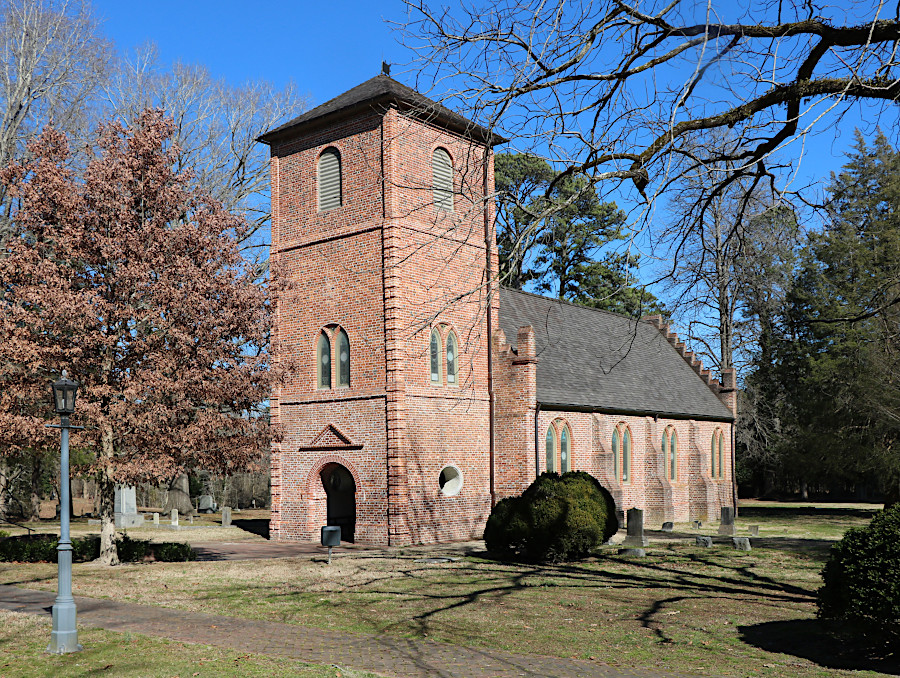
St. Luke's Church in Isle of Wight County, originally known as Newport Parish Church, was built near the end of the 17th century
Source: Virginia Department of Historic Resources, 081-0066 Timber Ridge Presbyterian Church (by Elizabeth Lipford/DHR, 2022)
Failing to at least pretend to be Anglican, and violating the standards established for identifying as an Anglican, could have significant consequences. Those who refused to have their children baptized could be fined in local county courts. The General Assembly ensured the parish vestries and county courts had the economic and legal resources to impose the beliefs of the Virginia gentry on all colonists:10
James II replaced Charles II after he died in 1685, and the crown shifted back to a Catholic. James II sought to legitimize Catholic religious practices and enable Catholics to serve in public offices. To accomplish that goal, he sought the support of the 15-20% of people in England who did not identify as Anglican, including Presbyterians and other Protestant dissenters as well as the Catholics.
In 1687, James II officially issued a "Declaration of Indulgence" that granted religious freedom to Catholics, Jews, Muslims, Unitarians, and other dissenters in England. They were no longer forced to speak the "Oaths of Supremacy and Allegiance" that had been required to hold civil and military offices, and were no longer subject to being fined for failure to attend Anglican church services.
In 1688, during a brief window of tolerance, George Brent became the only Catholic elected to the Virginia General Assembly during the colonial period. He served for one session, until King William and Queen Mary replaced King James II.
The Glorious Revolution of 1688 forced King James II out of power. English members of Parliament recruited King William and Queen Mary from the Netherlands to replace James II because they were Protestant rulers.
Under William and Mary, in 1689 Parliament did pass the Act of Toleration, officially titled "An Act for Exempting their Majestyes Protestant Subjects dissenting from the Church of England from the Penalties of certaine Lawes." Worship by non-Anglican Christians such as Presbyterians and Baptists remained acceptable under William and Mary, but only Protestant faiths were tolerated. Catholic priests were banned.
In colonial Virginia, religious toleration was limited. A 1699 law passed by the General Assembly authorized fining someone who did not attend a church at least once every two months unless they had an excuse accepted by the county court. Dissenters were exempted under the Act of Toleration, but only if they had gone to their own house of worship within the two month period. Attending church - some sort of Protestant church - was mandatory.
Under the Act of Toleration, Virginia's General Court in Williamsburg began to issue a license for non-Anglican Christian ministers to preach and organize churches. The license authorized preaching only in a fixed location, constraining the non-Anglicans who were itinerant preachers traveling constantly in the less-settled backcountry.
Ministers in the backcountry, where the Anglican church was least significant, were burdened by the requirement to travel to Williamsburg to get a license. Many of the Separate Baptists refused to apply for a license, claiming the civil government had no right to determine who was entitled to preach the word of God in a religious setting.
Licensing based on the 1689 Act of Toleration proceeded slowly:11
In the 1700's, immigrants from Scotland, Ireland, and Europe brought people with different religious beliefs to the colony, including German Pietist faiths, Lutherans, and Presbyterians. In the Great Awakening during the 1730s and 1740s, the number of dissidents expanded as religious fervor and more-emotional worship services than Anglican preaching increased in popularity. New religious practices were adopted, such as full-immersion baptism and the "laying on" of hands. Diversity of religious ritual and adoption of new styles of worship threatened the traditional social order in which acceptable behavior was determined by the gentry.
Other colonies had been more flexible on permitting different religious activities. The Calverts in Maryland had long recognized that toleration of non-Catholics was essential for attracting new colonists. That colony had passed "An Act Concerning Religion," also known as the Maryland Toleration Act, in 1649. When Virginia expelled Puritan preachers, Maryland welcomed them. From its start, William Penn's Pennsylvania colony was the most successful in attracting people with various Protestant beliefs.
Virginia's political leaders first embraced religious diversity in the 1720's. That decision was based on geopolitical considerations, rather than greater toleration or acceptance of other faiths.
Governor Spotswood saw the advantage in welcoming immigrants that had come from Ireland and modern-day Germany to Pennsylvania. Those immigrants desired to settle on cheaper land in the Shenandoah Valley, but were unwilling to become Anglicans. The dissidents were valued because new Protestant settlers on the western border would provide a buffer against raids by the French moving into the Ohio River Valley. The new colonists would also be a barrier against raids by Native Americans who were being displaced. The governor accepted that the Scotch-Irish and the "Pennsylvania Dutch" would worship and organize churches in ways different from the Anglicans.
Governor Gooch followed Spotswood's policy. Starting in 1730, Governor Gooch granted John and Isaac Van Meter 40,000 acres near Cedar Creek, Opequon Creek, and the Shenandoah River in order to attract more settlers, even though they would be non-Anglicans walking south from Pennsylvania.
On the eastern side of the colony at this time, settlers were finally beginning to fill up the Tidewater region but few had chosen to start farms west of the Fall Line in the Piedmont physiographic province. There were enough people in Stafford County in 1731 to justify splitting it and creating Prince William County, which initially included the land now within Fauquier, Loudoun, and Fairfax counties.
When colonial officials in Williamsburg issued large grants of land that was within the boundaries of the Fairfax Grant, Lord Fairfax decided to survey and establish his claim. The Van Meter brothers avoided getting trapped in what became an 80-year dispute over who had the authority to sell land in the Shenandoah Valley; they sold their claims quickly to Joist Hite.
Hite recruited his buyers from recent immigrants in Pennsylvania, as did others who got large grants of land west of the Blue Ridge. Quakers from Hopewell in Lancaster County, Pennsylvania migrated across the Potomac River and settled on land that had been granted to a Quaker (Alexander Ross) and a Presbyterian (Morgan Bryan). Those Pennsylvanians founded the Hopewell Meeting and built a log meetinghouse in 1734. It burned in 1757, and the Quakers built the first half of the current limestone meetinghouse between 1759-1761.12
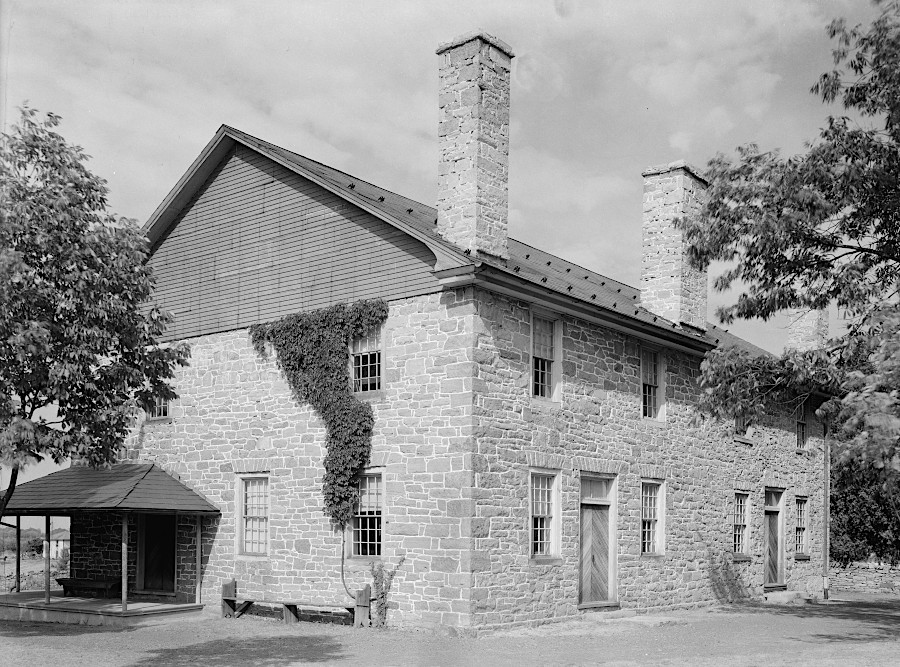
the plain and functional Hopewell Meetinghouse is the oldest house of worship in Frederick County
Source: Library of Congress, Quaker Meeting House, Winchester vic., Frederick County, Virginia
In 1732, Col. William Beverly obtained a grant further south in an area already known as the Irish Tract. He recruited more Scotch-Irish to purchase parcels within Beverly Manor and organized a town named after Governor Gooch's wife, Lady Staunton. In 1739 a Quaker from New Jersey (Benjamin Borden) got a large grant to the south of Beverly Manor, in what now is Rockbridge County.
Beverly partnered with Irish ship captain James Patton. He brought immigrants directly from Ireland up the Potomac River, and then walked them west across the Blue Ridge into the Shenandoah Valley. Patton later got his own grant on the New River. He populated Dunkard's Bottom, now flooded by Claytor Lake, with Anabaptists known as "Dunkers" (similar to Mennonites and Amish, and named for the practice of full-immersion adult baptism) from the German Pietist community in Ephrata, Pennsylvania.
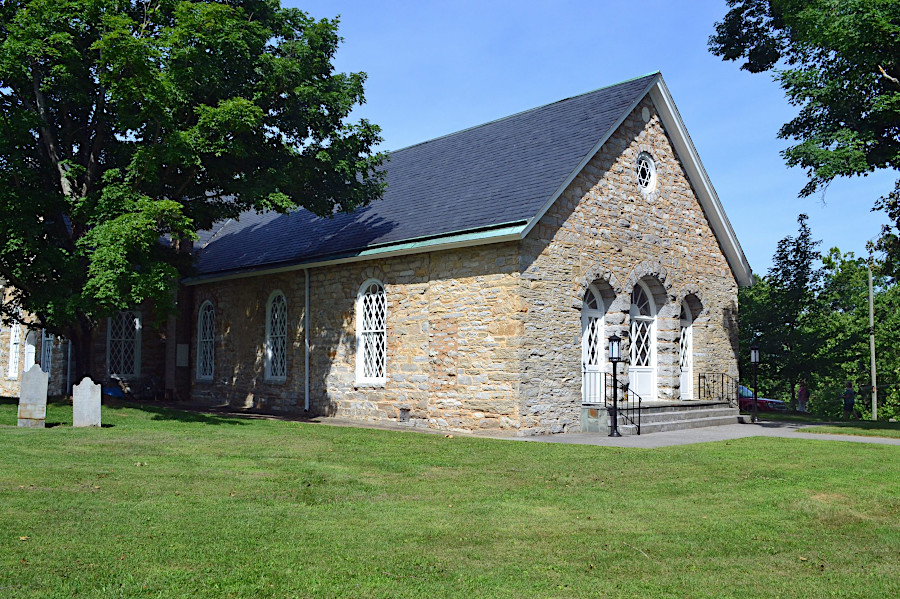
Timber Ridge Presbyterian Church in Rockbridge County, built in 1755, is the second oldest Presbyterian house of worship in the Shenandoah Valley
Source: Virginia Department of Historic Resources, 081-0066 Timber Ridge Presbyterian Church (by Calder Loth, 2017)
East of the Blue Ridge in Hanover County, in 1743 "ordinary" people led by a bricklayer began reading religious tracts on their own and were inspired by George Whitefield's revivals. They developed different interpretations than what was preached by government-paid Anglican ministers.
Religious dissidents started holding their own meetings, independent from the Sunday services led by the Anglican minister of the parish. Some dissidents were fined by the county courts for failing to attend Anglican church services, but the community of dissidents expanded in Hanover County and finally recruited a Presbyterian minister from Southwest Virginia to preach.
Rev. Samuel Davies first came to Hanover County in 1747. In 1752, he obtained an official opinion from the attorney general in England that William and Mary's Act of Toleration did apply to the colony of Virginia, as well as in England. That decision affirmed the legal right of Presbyterians to preach and for meetinghouses of dissenters (the alternative to attending Anglican churches) to be authorized. However, dissenters listening to Davies and other Presbyterian ministers were still required to pay the county taxes that funded operations of the Anglican parishes and paid salaries for Anglican ministers.
When Anglicans in a community felt threatened by the growth of the "New Light" Presbyterians, the county court had the legal authority to limit activities of the dissenters. In 1758, the Lancaster County court revoked a license which it had issued "unadvisedly" for a Presbyterian meetinghouse.
The slave-owning elite used the power of local government to limit missionary work by dissidents within the enslaved population. In a radical break from Anglican tradition, Baptists worshipped in mixed-race congregations, baptized free and enslaved blacks, and allowed women to have leadership roles. New religious beliefs that led to overt violation of social norms, especially the crossing of racial boundaries, threatened the traditional political power structure within the colony as much as the potential of a French army marching southeast from the Ohio River.
The Separate Baptists did not require that their preachers be ordained or educated; those who felt the call to preach were welcomed by a gathering. In contrast to the Church of England, which struggled to fill pulpits in different churches with "qualified" ministers who had an appropriate social background, dissident groups did not suffer a serious shortage of preachers.
The gentry's prejudice against Presbyterians moderated after the Baptists emerged; Anglicans began to view the Presbyterians as a less-threatening group. Expansion of the Separate Baptists in Virginia began in the 1750's, at the same time the colony needed to recruit troops for the French and Indian War. Local militia leaders, typically also close allies or even members of the Anglican vestry, had to ameliorate their prejudice against Presbyterians and Baptists in order to recruit soldiers to join the Virginia Regiment of Provincial Regulars that George Washington led.
Growth of religious dissidents was facilitated by support from "outside agitators:"13
Though still practicing as ministers of the Church of England until 1784, Methodists ministers began to split the established church after Robert Williams arrived in 1772. Methodist preachers did not defend slavery, in contrast to the interpretation of the Bible offered by traditional Church of England (Anglican) ministers.
The Great Awakening in the mid-1700's increased the importance of religion in public life, but spurred more Virginians to break with Anglican traditions and chose their own leaders without endorsement by the parish vestry. As worship rituals and theology became a personal choice, the role of the established church was minimized.
Authority in colonial Virginia was exerted through "soft power." How the elite dressed, the architecture of their mansions, and seating arrangements in church defined who was powerful and could command obedience.
County sheriffs had the power of arrest. However, in contrast to today, during colonial times there was no police force routinely on patrol enforcing a thick book of laws governing behavior. Informal rules of behavior, rather than formal laws and regulations, shaped how people acted. Other than slave patrols there was no equivalent to the modern practice of selective police enforcement routinely targeting minority groups, such as traffic laws.
People complied with colonial laws and social norms out of tradition and respect for the wealthy elite. That pattern of behavior was reinforced in Anglican churches every week. During the 1700's there was a fundamental assumption that colonial Virginia should be a hierarchical society, with a tiny top class of wealthy and powerful people and a large bottom class of enslaved people defined by skin color. Behavior of the enslaved was controlled by force when necessary. Behavior of white colonists was controlled by custom, with weekly sermons by Anglican ministers justifying the social structure.
The emergence of alternatives to the Church of England created new centers of authority. Diversity threatened the traditional hierarchy. As Presbyterians and Baptists attracted more followers, lower respect for men serving on the Anglican vestry reduced the informal authority exerted by elite families over the white population.
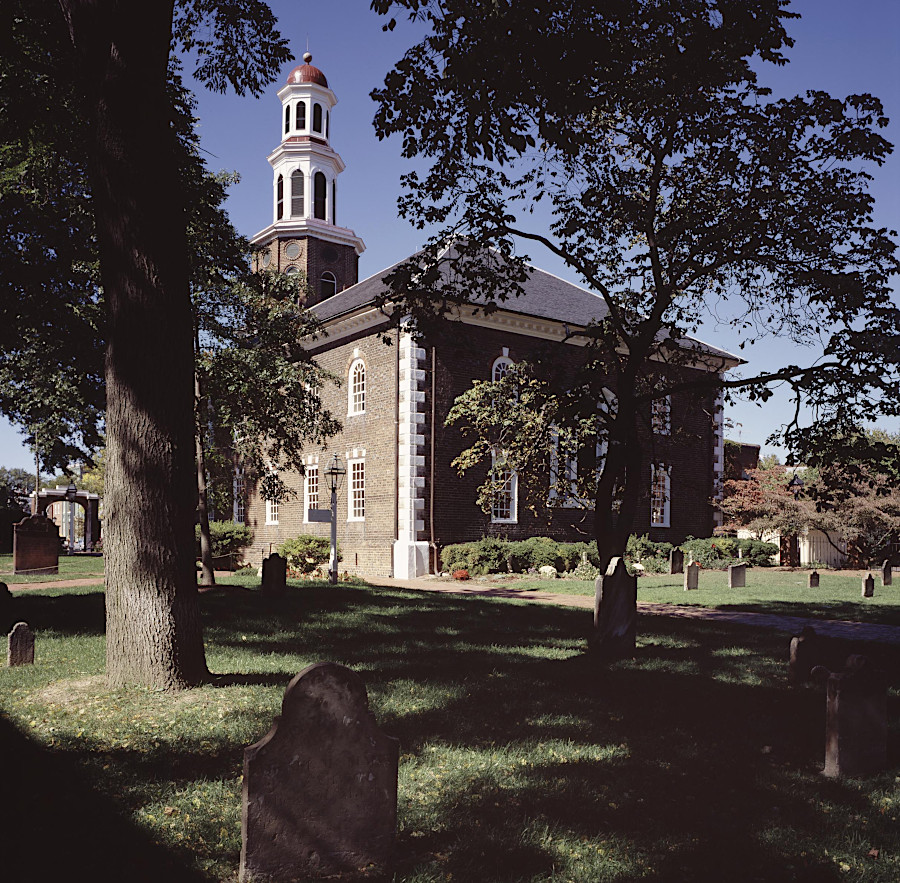
the architecture of Christ Church in Alexandria was intended to convey power and strength
Source: Library of Congress, Christ Church, Alexandria, Virginia
Finding qualified Anglican ministers to fill the pulpit in every parish was always challenge. It was difficult to recruit the best and brightest Anglican ministers to the colonies from England. Even poorly-trained Anglican ministers ordained on the eastern side of the Atlantic Ocean could find a better job in England.
Part of the recruitment problem was that ministers were not automatically held in high respect by the congregation or the vestry that ran a parish in colonial Virginia. Upper class Virginians did not view serving as a minister as an honorable profession, and discouraged their children from taking such positions. Many ministers in Virginia parishes came from Scotland and Ireland, and were viewed as coming from a "lower class" than the members of the vestry. The behavior of some Anglican ministers involving alcohol and sex was inconsistent with the moral teachings in the Bible, further undercutting the reputation of ministers.
The failure to send an Anglican bishop to Virginia who could ordain ministers in Williamsburg limited the organization, discipline, and political independence of the established church. The Bishop of London sent a Commissary to oversee the work of the Church of England.
The most influential Commissary was James Blair, who served from his appointment in 1689 until his death in 1743. He arranged for the founding of the College of William and Mary in 1693, and arranged for ministers to be appointed whenever there was a vacancy in a parish. The glebe of the Henrico Parish served by Rev. Blair was Varina Plantation. He lived there between 1685 and 1694.
Varina Plantation was also the Henrico County seat, the location of the local courthouse, for 120 years between the founding of the county in 1632 until 1752. However, the story that it was the home of Pocahontas and John Rolfe is unverified. Henrico County purchased the 2,095-acre plantation in 2024 to preserve the historical site and its open space.
Some ministers preferred having the presiding bishop living on the other side of the Atlantic Ocean, and just a Commissary in Williamsburg with limited disciplinary powers. In 1661, the General Assembly had required that only ministers who had received ordination from "some Bishopp in England" could preach in Virginia.
Anglican ministers were thought to be empowered in the apostolic succession from Jesus through the laying-on of the hands of a bishop. Vestries later had the option of hiring ministers who had not received ordination directly from a bishop, but such ministers lacked a clear claim to apostolic succession.
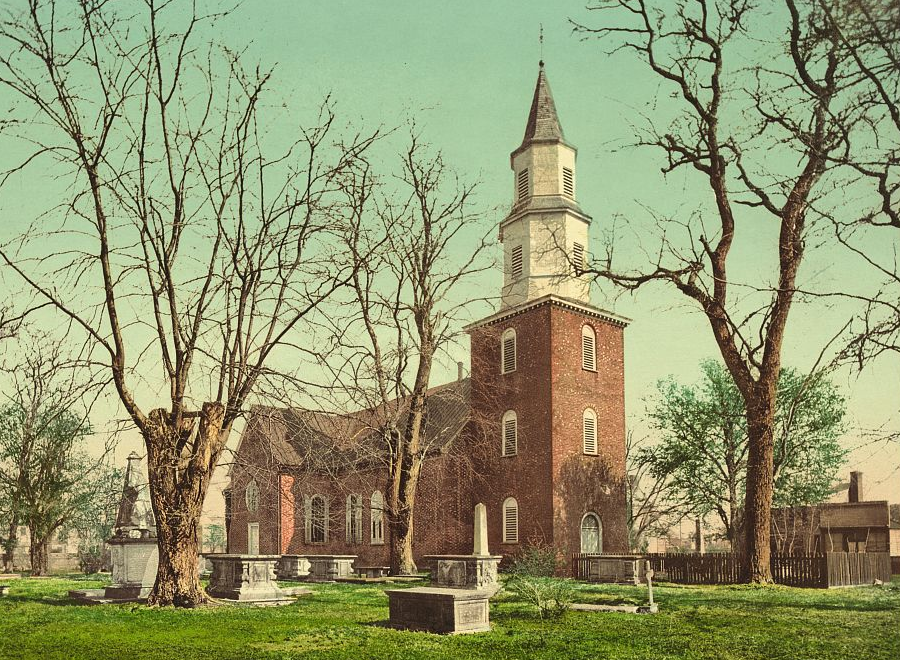
Bruton Parish Church was the center of religious activity for government officials when Williamsburg was the colonial capital of Virginia
Source: Library of Congress, Bruton Parish Church, Williamsburg, Virginia
Whatever their qualifications beyond public speaking skills sufficient to stir a crowd in a pub or a church, Anglican ministers traveled from England to Virginia with realistic expectations of having a job. An ordained Anglican minister, even one with low personal character and minimal theological training, recognized that some Virginia parish would have a vestry that could not afford to be very selective.
Anglican church operations were funded completely by the taxes imposed by the local parish vestry. Wealthy Virginia landowners controlled the vestries in each parish, so the landowning elite determined how much they would tax themselves. in particular, the vestry composed the timing of the extra tax burden required to build new churches or "chapels of ease" in the periphery of the parish. The extra burden would be most acceptable after years in which tobacco prices and crops had generated a good income.
Ministers were guaranteed a salary while serving a parish, and had some personal income from farming operations on the parish glebe. Vestries were careful before making a long-term commitment to support a minister. They ensured the minister would not threaten the authority of the local wealthy landowners before giving the minister the equivalent of tenure.
Many vestries avoided having their minister "inducted" by the Commissary or Governor, a process which essentially granted them a permanent job unless caught in serious misbehavior. Instead, vestries hired ministers using essentially year-to-year contracts. A dissatisfied vestry could choose to tell a minister that his contract was ending, even though recruiting a new minister would be a challenge.
One vestry in Richmond County tried to fire the minister in 1749 after the dominant landowner, Landon Carter, developed a person prejudice against him. The church door was nailed shut to exclude the minister from the building, and tenants on his glebe lands diverted products from the minister's livestock. The minister responded by filing a lawsuit against the tenants and not the vestry, and he won damages in the county court.
The General Assembly responded to that scandal by giving all Anglican ministers the equivalent of tenure without requiring formal induction in Williamsburg. However, the increased financial security did not translate into increased social status for ministers. The Richmond County case exacerbated the division between the elites in the vestries and the members of the parish vs. the ministers in the pulpits. Support for the established church diminished as ministers became perceived as mere employees, reduced to suing their employers for payment of wages.14
The Parson's Cause case in Hanover County highlighted that the general public's perception of ministers was comparable to the gentry's lack of deference to ministers.
Vestries paid their ministers in tobacco rather than in cash, since specie was rare in the colony. Since 1749 the pay of ministers had been fixed by the General Assembly at 16,000 pounds of tobacco per year, plus income from glebes.
while the Virginia economy was disrupted by the French and Indian War, the price of tobacco climbed during a severe drought in 1755. The shortage of the crop led to a sudden 300% increase in the value of tobacco, from two pence per pound to six pence per pound.
The General Assembly, in which no minister served, responded to the inflated price of tobacco by passing a Two-Penny Act in 1755. After another season of bad weather in 1758, the General Assembly passed another Two Penny Act in 1758. Both laws were short-term responses to the tobacco shortage, and expired after one year.
The laws authorized vestries to pay ministers according to the normal price of tobacco, two pennies per pound - not the temporary inflated value 300% higher. In 1758, the ministers expected to sell their tobacco and collect £450 rather than the usual £150. Tripling of their salary was an opportunity to become wealthy enough to raise their social status and increase clerical independence.
In response to the 1758 bill preventing a salary windfall, one minister expressed openly his hostility towards the legislators:15
The dispute over pay evolved into a dispute over authority in the colony. Half the Anglican ministers in the colony assembled in a convention and sent Reverend John Camm of York County to London. His goal was to get the 1758 Two-Penny Act disallowed.
Acting as the lobbyist of the clerics, Camm argued that the General Assembly's law challenged royal supremacy, and claimed that the House of Burgesses was acting treasonously. Once the ministers sent an official representative to get officials in London to overturn the Two-Penny Act passed in Williamsburg, the colony's political leadership faced a direct challenge to their authority.
The Privy Council did overrule the 1758 Two Penny Act, but did not state if the decision was retroactive. To collect "back pay," three ministers filed lawsuits in 1762-63. They asked the county courts in Virginia to force their vestries to pay the difference between the market value vs. the fixed price of 16,000 pounds of tobacco, for those years when the law was in effect.
Rev. Alexander White filed a lawsuit in King William County, and Rev. Thomas Warrington sued in Elizabeth City County. The jury in King William County ruled against Rev. Alexander White. The justices in Elizabeth City County dismissed Rev. Thomas Warrington's case, after the jury returned an open verdict.
Rev. James Maury's lawsuit was heard by the court in Hanover County, not where he was serving in Louisa County. Rev. James Maury won his case, triggering a second phase of the trial in which the jury had to determine how much money Rev. Maury would be awarded as damages.
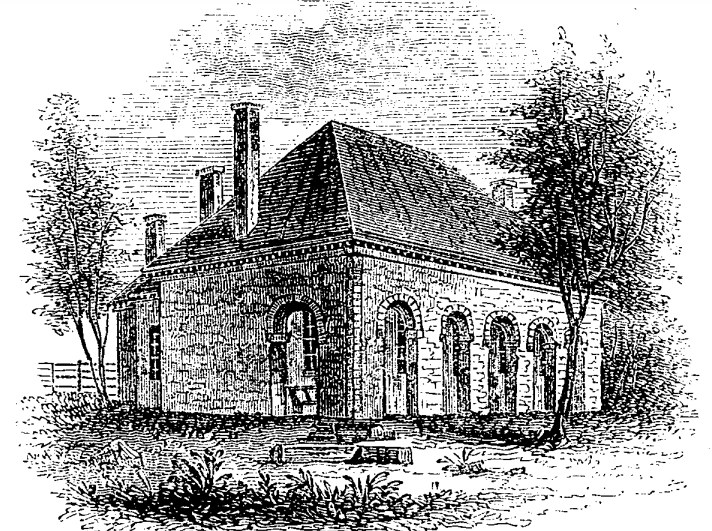
Patrick Henry argued the Parson's Cause in Hanover Court House, where his father was the presiding judge
Source: Benson Lossing, The pictorial field-book of the revolution (Volume 2, p.429)
Rev. Maury was surprised to discover that the sheriff did not assemble a jury of gentlemen who would be deferential to a Church of England minister that the local vestry had chosen. Instead, in Maury's terms, the sheriff "went among the vulgar herd." Among those seated in the jury box were several New Light dissenters.
Patrick Henry was the vestry's defense lawyer during the sentencing phase of the "Parson's Cause" case. He made a powerful speech that conflated the power of the clergy and the British government, painting them both as oppressive burdens on Virginia society. Some thought Henry had crossed the line and advocated for treason.
The Hanover County jury awarded Rev. Maury just one penny in compensation, not the anticipated £300. The token damage award reflected both the effectiveness of Patrick Henry's oratory and the low support for Anglican ministers among the "vulgar herd." The jury's verdict also reflected the emerging resistance in Virginia against the authority of the British Parliament and King George III, which Patrick Henry inflamed in 1765 with his speeches against the Stamp Act.16
Source: Historic St. John's Church, The Story of the Parson's Cause with John Tucker
The Anglican clergy's attempt to use county government power to increase their pay backfired. Lawsuits by ministers in county courts, trying to force the local taxpayers to provide funding after failing to obtain local support from the parishioners, helped to poison the close relationship between civil leaders within the Virginia gentry and the Church of England. In the 1760's and 1770's, while challenging the local political authority in Virginia, Anglican ministers preached about the requirement to support distant political authority in London. Not surprisingly, the colonial gentry who controlled county courts and the General Assembly did not view those ministers as allies.
In the first official meeting of the General Assembly in 1776, after the Fifth Virginia Convention had declared independence, the legislators of the new Commonwealth of Virginia eliminated the mandatory taxpayer support for minister salaries. That left the ministers dependent upon donations and income from glebes, without a guarantee of 16,000 pounds of tobacco per year raised from local taxpayers.
The Anglican Book of Common Prayer included praying for the King of England, who was also the head of the church. By the mid-1770's, such an endorsement of the king was unacceptable in many Virginia parishes.
Many Anglican ministers avoided the impacts of the America Revolution by returning to England. In the absence of replacements arriving from Great Britain, lay leaders in the vestry arranged for religious services or churches simply closed down.
Almost another decade of debate was required before the Church of England finally lost its status as the "established," official church in Virginia. The church was "disestablished" in 1786, when the General Assembly passed the "Bill for Establishing Religious Freedom," revising the bill which Thomas Jefferson drafted originally in 1777 as Bill No. 82.
Had the Anglican ministers chosen to support colonial authority in the 1750's and 1760's, rather than ally with royal officials in hopes of winning back pay, the Church of England may have morphed after 1776 into the Church of Virginia. It could have retained its primary status as the state's official religion, supported in some way with taxpayer funding. Instead, Virginians abandoned the Church of England and chose to becomre members of other denominations.
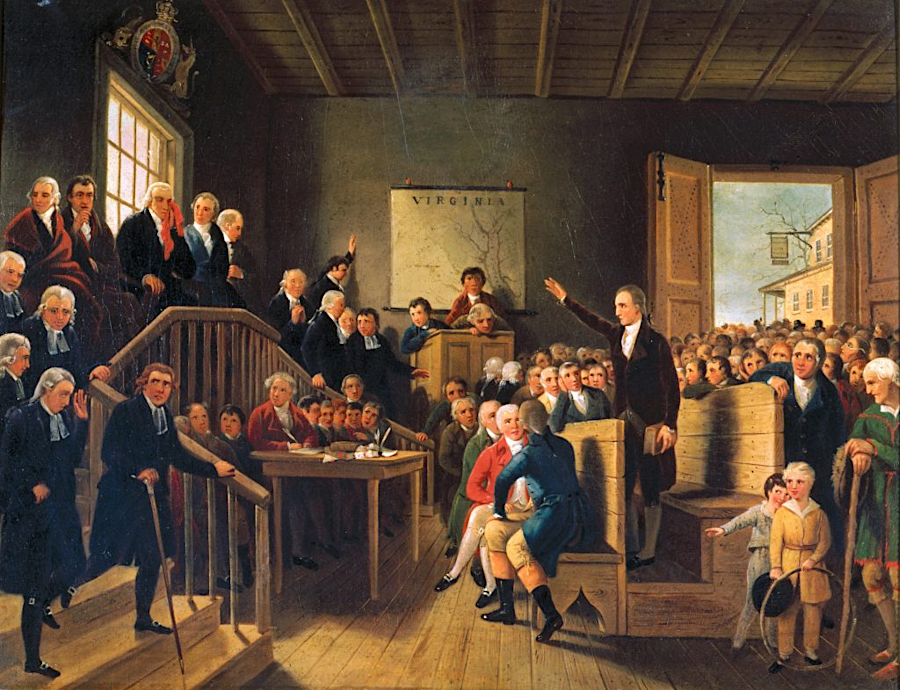
Patrick Henry portrayed the Church of England as an oppressive agent of English governmental power in the 1763 Parsons' Cause case
Source: Encyclopedia Virginia, Patrick Henry Argues the Parsons' Cause (c. 1834 painting by George Cooke, now at the Virginia Museum of History and Culture)
Before 1776, repression of dissident ministers by Virginia officials also undercut public support for the established church. Some Separate Baptists who refused to get official licenses, and who drew large crowds to worship services, were a target for Anglican ministers who resented the competition.
In several counties, Anglican ministers willing to force conformity with Anglican beliefs recruited the county sheriff to break up "unlawful assemblies." Baptist preachers were jailed for breaking the peace and preaching without a license, and even dragged from the pulpit and whipped in public. A mob in Stafford County tossed a live snake and a hornets nest into a Baptist meetinghouse.
Though Anglican ministers may have cared about religious orthodoxy, local officials may have been more alarmed by the threat created by religious dissidents to the traditional social order. Anglicans in a parish were governed by a vestry in which existing members chose replacements for those who died or retired. In contrast, Presbyterian congregations elected their leaders directly.
More dangerously, Separate Baptists created mixed-race gatherings and empowered women as Baptist "deaconesses." That challenged the hierarchical colonial power structure in which the authority to own property and make official decisions was limited primarily to just white men.
Some of the gentry objected to the abuse of unlicensed preachers and to the disruption of Baptist meetings by Anglican ministers and county sheriffs. James Madison, though a wealthy slaveowner and member of the gentry, had been educated by Presbyterian clergymen at Princeton. He was appalled by the mistreatment of Baptists in Caroline and Culpeper counties and came to their defense.
The start of the American Revolution forced a break first with Parliament's authority and then with the head of the Church of England, King George III. The now-rebel leaders in the five Virginia Conventions recognized the need to generate broad public support, in order to spur enlistment in the militia and Continental Army by the marginalized Baptists and Presbyterians. Perhaps 1/3 of the 200,000 white Virginians at the start of the American Revolution were dissidents.
In 1775, Baptists requested that their ministers receive equal status in the army being raised to fight the British. Patrick Henry led the successful effort for ministers of Anglican and dissenting faiths to be acknowledged equally in the colonial militia.
Independence created the opportunity for dissenters to obtain greater legitimacy, as the Anglicans in Virginia rejected the combined religious/political authority of King George III. So long as the head of the church was also the head of the state, rebellion against one was rebellion against the other. The political split with King George III and Parliament was accompanied by a parallel split with the authority of the Church of England.
After declaring independence, the General Assembly found no way to create a new entanglement of religious and political power. Virginia's revolutionary leaders could not identify a single denomination that would replace the Church of England as the established, official Commonwealth of Virginia religion; there were too many separate dissenting groups.
When Thomas Jefferson first drafted a document to explain why the 13 colonies were declaring independence, he wrote "We hold these truths to be sacred & undeniable, that all men are created equal..."
Jefferson was unhappy with the editing done by the Committee of Five and by the Continental Congress before adopting the Declaration of Independence, but one of the few suggestions made by Benjamin Franklin helped clarify the intention to eliminate divine authority as the basis for political power. Franklin recommended Jefferson replace "sacred & undeniable" with "self-evident." That change eliminated the religious justification for empowering the new American government.17

in 1776, Thomas Jefferson accepted Benjamin Franklin's suggestion to change "sacred & undeniable" to "self-evident"
Source: Library of Congress, Writing the Declaration of Independence, 1776 (Jean Leon Gerome Ferris, 1932)
For the same reason, the US Congress did not establish an official language for the new country. Assimilation of various immigrant groups into a "melting pot" in the 1700's required accommodating the German-speaking residents in particular. Leaders after the American Revolution sought to build a closer sense of national identity, but without defining English-speaking residents as privileged with higher status.
As ceremonies to commemorate the 250th anniversary of the American Revolution began in 2025, however, President Trump broke tradition. His campaign for a second term had highlighted perceived threats from immigrants, particularly those crossing the border with Mexico. President Trump had the Spanish-language version of the official White House website deleted, and issued an Executive Order that defined English as the official language of the United States of America. Over 30 states had already adopted English as their official language for dealing with state agencies, while Hawaii and Alaska also defined additional languages within those states as "official."
The Executive Order eliminated the requirement, started in 2000, for Federal agencies to provide language assistance to non-English speakers. At the time, over 20% of residents within the United States spoke one of 350 languages other than English at home, but over 90% had the ability to speak English "very well." Canada had already defined both French and English as the official languages of that country, while Mexico (and the United Kingdom) did not have one.
Starting in 1776, Virginia's leaders structured a new form of government in which individuals could choose their own church, rather than have the government define the "right religion." The process of breaking with the Church of England occurred in fits and starts; the official split ("disestablishment") did not occur until 1786.18
The June 12, 1776 Virginia Declaration of Rights established a clear separation between the authority of the state vs. the power of the individual regarding faith and religious practices. Virginia's revolutionary leaders specifically rejected the power asserted by the King of England to be Defender of the Faith, with the authority to establish official religious dogma. Section 16 of what became the "Bill of Rights" in all Virginia constitutions stated instead:19
Referencing "Christian forbearance" prioritized that faith over others. In the 1901-1902 convention that revised the state constitution, an effort was made to remove the adjective "Christian." The proposed change was intended to clarify that the state government in Virginia was completely neutral regarding different faiths; Jewish forbearance was as relevant as Christian forbearance. That effort failed in 1902.
When amendments were prepared in 1969-1970 to essentially replace the 1902 constitution, State Senator Henry Howell tried again to get the word "Christian" deleted. That effort also failed. The reference to Christian forbearance is still in the state's constitution.
The 1776 Virginia Declaration of Rights had been drafted primarily by George Mason. When he finally arrived to join the debates, the president of the Fifth Virginia Convention, Edmund Pendleton, declared optimistically:20
Mason's first draft for the Fifth Virginia Convention had proposed only that "all Men shou'd enjoy the fullest Toleration in the Exercise of Religion." However, 25-year old James Madison successfully argued that the draft should be revised beyond "toleration" which could be revoked by the legislature. Madison took the lead on the religious liberty issue during the Fifth Virginia Convention in part because Thomas Jefferson was at the Continental Congress in Philadelphia.
Madison pushed for the declaration to be amended so it defined religious belief as a natural right, one which could not be directed by government. George Mason endorsed Madison's revision of his draft, and the final document ended up saying:21
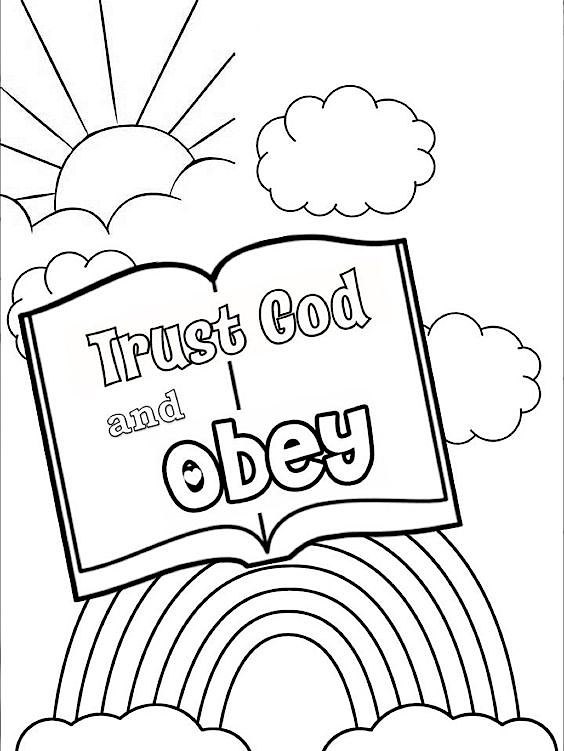
Madison prevented the newly-independent Commonwealth of Virginia from basing its authority for governing people on a religious basis
Source: Pinterest, Trust and obey coloring page
However, the convention rejected Madison's proposal (...no man or class of men ought, on account of religion be invested with peculiar emoluments or privileges) to disestablish the Church of England and block public funding for all churches. Changing the traditional perspective of the relationship between church and state, and separating the two in Virginia, required another 25 years.
The Virginia Declaration of Rights was the boldest in all the colonies for separating church and state. It came at the start of the American Revolution. Religious dissidents recognized that the need to recruit soldiers would once again create an opportunity to eliminate the obligation to fund an established church with a different faith.
On June 20, 1776 the the Fifth Virginia Convention received a petition from the Baptists in Occoquan making clear that local dissidents linked their support for the convention's policies with the convention's support for religious freedom. The petition asked:22
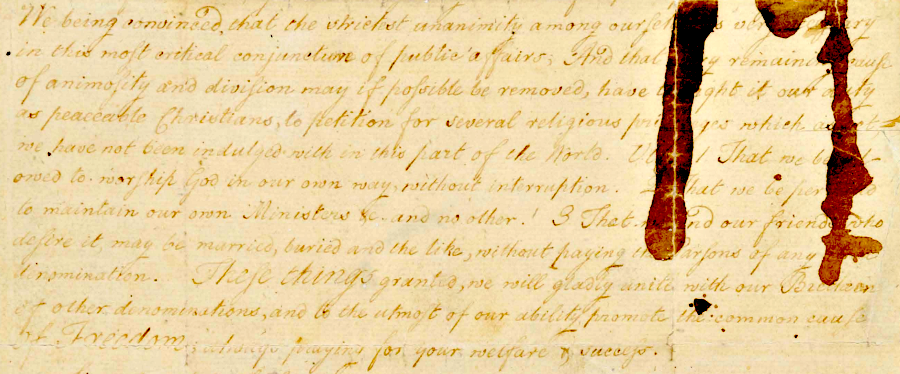
Baptists in Occoquan petitioned to eliminate powers of the Church of England, as a condition of their support for the policies of the Fifth Virginia Convention in 1776
Source: Library of Virginia, Petition of members of the Baptist Church at Occoquan, 1776 June 20 (laid before the Convention)
Through legislation by the General Assembly, Virginia became the only state to eliminate religious restrictions that limited who could be elected to office. Catholics were finally allowed to serve, if they could get elected despite continuing local bias among the voters. Only the traditional ban on ministers being elected to the legislature was retained by the General Assembly.
After 1776, New England states continued to require compulsory financial support for religion. The Massachusetts tax to support "public Protestant teachers of piety, religion, and morality" did allow taxpayers to designate their payment to their own denomination or sect, so long as it was Protestant. The Maryland Declaration of Rights authorized the state to collect a tax to support religion, though the state never passed such a tax (emphasis added):23
Jefferson consulted Mason's Declaration of Rights when preparing the Declaration of Independence in June, 1776. However, based on feedback from Benjamin Franklin, the initial reference to "sacred" authority was removed from the Declaration of Independence. The Articles of Confederation, approved by the Continental Congress and 1777 and finally ratified by the states in 1781, included only this mention of religion in Article III:24
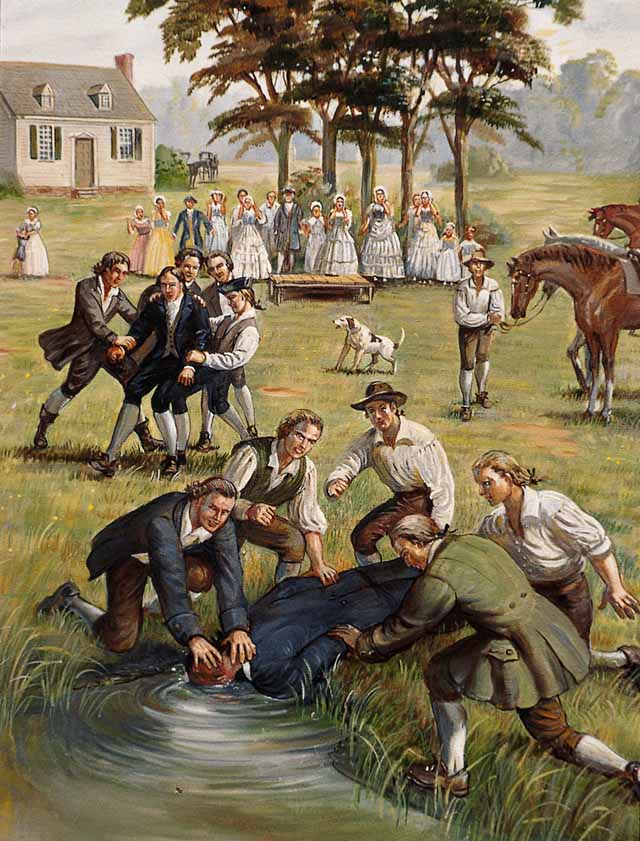
even after adoption of the Virginia Declaration of Rights, non-Anglican worship services were disrupted and preachers were harassed
Source: Library of Congress, Religion and the Founding of the American Republic, The Dunking of David Barrow and Edward Mintz in the Nansemond River, 1778
After Virginia declared independence in 1776, the Fifth Virginia Convention edited the Book of Common Prayer. The legislature mandated that prayers for the King and Realm of England be removed. In that requirement, the new state government continued the pattern of telling ministers what to preach in their religious services. Anglican ministers had to comply, leave the pulpit for some other line of work, or return to England.
The new General Assembly inherited from its colonial predecessor an established church, with 98 parishes created prior to independence. What had been the Church of England became the Church of Virginia, and became known as the Protestant Episcopal Church. One result was that the official link with the Diocese of London was broken, and there was no bishop in America who was authorized to ordain new ministers.
The long tradition of an intertwined shurch and state did not evaporate overnight. In 1776, when the 6th Virginia Regiment was being organized at Williamsburg, the colonel ordered his soldiers to attend church at 3:00pm on a Sunday afternoon.

soldiers in the 6th Virginia Regiment were commanded to attend church on a Sunday in 1776
Source: Huntington Library, Orderly book of the 6th Virginia Regiment, with records of Flatt Creek and Grove Brook plantations, 1776-1811
During the American Revolution, the Virginia legislature continued to create new parishes as population expanded. Six more were authorized by 1780, reaching a total of 104 parishes. Parishes were responsible for some government services such as care of the impoverished and orphans, in addition to overseeing worship services and hiring ministers.
Vestries continued to exercise authority at the local level in parallel with county courts during and after the American Revolution. Members of the vestry appointed their replacements on the vestry, so members of the elite gentry always stayed in control. Local residents had no opportunity to vote for the vestry members who hired ministers. Local residents also lacked the ability to vote for the justices of the peace who formed the local court; those county officials were appointed by the General Assembly.25
The first Constitution of Virginia, adopted in June 1776, created three branches of government - legislative, executive, and judicial. No religious institution was created as a fourth branch of government.
The 1776 state constitution prohibited all ministers from serving in the General Assembly. That ban minimized the potential that enough religious officials could gain power and impose their beliefs on others. Throughout the colonial period, no ordained minister had been allowed to serve in the House of Burgesses. On the rare occasions when a minister was elected, the burgesses blocked the minister from taking his seat. The Governor's Council was not restrictive, however, and the Commissary of the Bishop of London sat on the Council.
After the 1836 elections for the General Assembly, the legislators had to act on that ban. A Methodist preacher, Humphrey Billups, was elected to the House of Delegates. The decision was clear - his credentials were rejected by a 179-2 vote.
The ban on ministers serving in the General Assembly was retained in all revisions of the state constitution until after the Civil War. The "Underwood Constitution" of 1870 finally eliminated the prohibition.26
After adoption of the state constitution in 1776, sheriffs in Virginia counties continued to collect mandatory taxes used to pay salaries of the Anglican ministers remaining in Virginia parishes. Ministers from other denominations received no such funding from the state government. Baptists, Methodists, Presbyterians, and other dissenters organized a petition drive to end the requirement to pay taxes to support the established church.
Advocates sewed together 100 pages to create an impressive "Ten Thousand Names Petition," and it was submitted to the General Assembly on October 16, 1776. The legislature responded by passing "An act for exempting the different societies of Dissenters from contributing to the support and maintenance of the church as by law established, and its ministers, and for other purposes therein mentioned" on November 19, 1776.
That bill temporarily suspended the state's funding. Anglican ministers had to rely upon donations plus revenue generated from glebes. Farming and other activities on the glebe were expected to generate income to supplement the salary provided to the minister.
The glebes were parcels of land previously acquired by local vestries when a parish had been created, or when enough funding had been obtained to purchase a tract of land. The funding to purchase glebe lands came from a tax set by the vestry and collected by the county sheriff.
The same 1776 law that suspended the tax to support Anglican ministers explicitly authorized the vestries to continue to levy a tax in order to provide services to the poor. The Church of England remained the official state church. The legislature did not change the powers of the established church to manage local social services such as caring for the indigent and the infirm who were impoverished, adoption of orphans, and dealing with illegitimate children of indentured servants. Vestries were tasked with civil duties, and funded so those duties could be performed.
The law also protected the existing property rights of the Anglican vestries:27
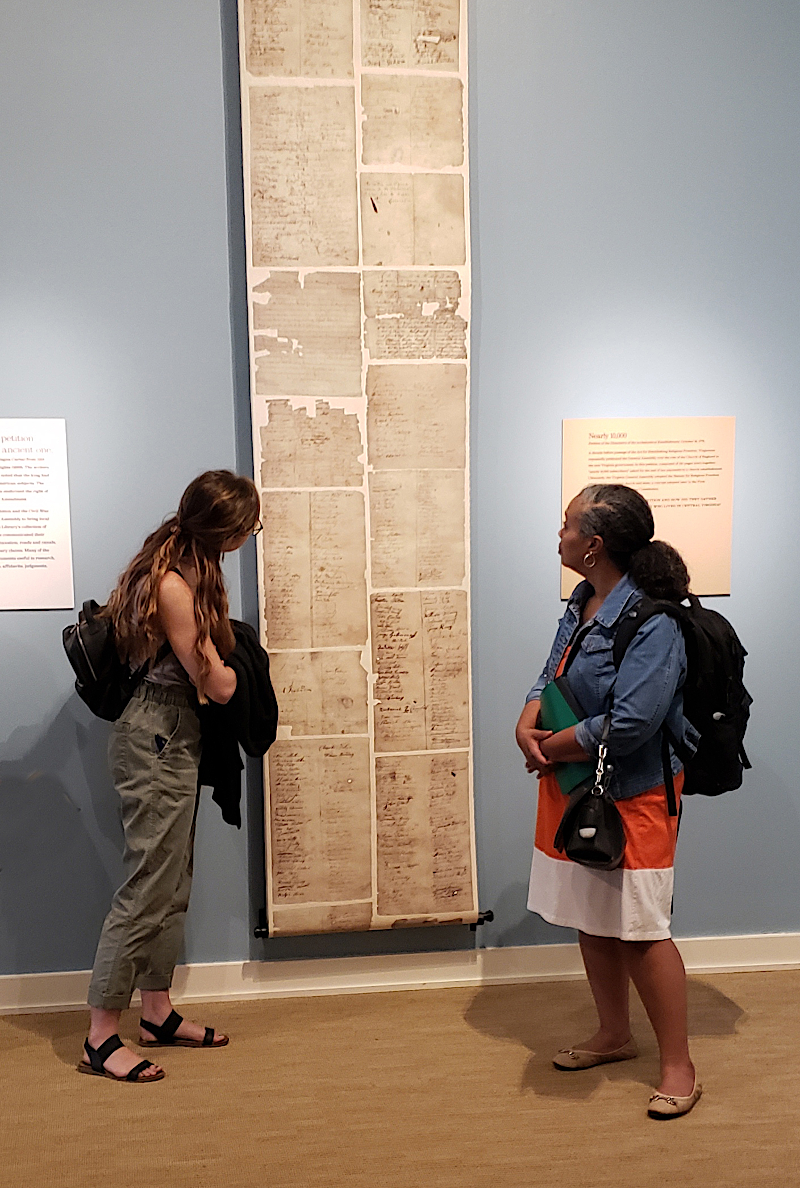
a replica of the Ten Thousand Names Petition, on display at the Library of Virginia
Source: UnCommonwealth blog, Library of Virginia, "That The Oppressed May Go Free": A Petition To The Virginia General Assembly For Religious Freedom
Philosophically, Jefferson thought that the opinions of men are not the object of civil government, nor under its jurisdiction. He sought to eliminate government authority over religious beliefs and practices, but was unable to get a majority of the General Assembly to support his approach in 1776. At the start of the American Revolution, the legislators had higher priorities to address.
The Continental Congress did make clear that it supported religious freedom in 1776, long before the First Amendment was added to the constitution that would be ratified in 1788. It decided on August 14, 1776 to issue a proclamation to the German troops brought by Great Britain to New York and invite desertion. To incentivize the "Hessians" to choose to live in America, the Congress said:28
After 1776, the Church of Virginia no longer received funding from the taxpayers and had to rely upon voluntary contributions plus income from its glebes and other property. However, it had not been "disestablished." It remained the official church of the new Commonwealth of Virginia. Those who were not Anglicans were still dissenters from the official government faith.
For the first decade of independence, Virginia legislators discussed the possibility of using taxpayer funding to support all religions. Mandating a "general assessment" for distribution to all religious denominations was a politically attractive way to restore the funding for the Anglican ministers. Rather than list which specific denominations qualified for funding, the proposal for a general assessment would allow a group of five males to form a church and qualify for public funding.
Under that approach, mandatory taxes to support churches would be collected. Funding would be distributed to different faiths, and in some proposals the taxpayer could specify the recipient. Anglicans, who began calling themselves Episcopalians, were strong supporters of renewed financial support from the state. Some dissenters supported that approach, recognizing it would guarantee funding for their religious organizations.
Thomas Jefferson opposed the concept of state-supported religion. He drafted his "Bill for Establishing Religious Freedom" first in 1777, when he was part of a team rewriting Virginia's colonial laws to reflect the new condition of independence. He started as one member of a five-person Committee of Revisors that included George Mason, Thomas Ludwell Lee, George Wythe, and Edmund Pendleton.
All five were together in Fredericksburg on January 13-17, 1777 when Jefferson drafted "Bill No. 82: A Bill for Establishing Religious Freedom." Mason and Lee soon dropped off the Committee of Revisors, and Jefferson ended up doing most of the work preparing 126 bills to establish a new foundation for Virginia law.
In his research, Jefferson discovered that there was no single law which "established" the Church of England as Virginia's official religion. Multiple laws had to be revised in order to accomplish his goal:29
After being elected governor in 1779, Jefferson served on the Board of the College of William and Mary. He had the program of education revised to eliminate the training of Anglican ministers. The school had been chartered in 1693 so:30
The College of William and Mary had trained ministers for over seven decades. Until the American Revolution, those who qualified would travel to London to be ordained before returning to Virginia and serving in a parish.
Jefferson transformed the curriculum and eliminated all of the religious training. Funding for the Divinity School was diverted to other college expenses and the college became a secular institution.
Jefferson thought his "Bill for Establishing Religious Freedom" might pass the General Assembly in 1779. It was introduced as Bill No. 82, one of five bills related to religion in the list of 126 bills prepared by the Committee of Revisors. Bill No. 82 focused on preventing the state from compelling individuals to support any particular religious group and insuring the civil rights of individuals would not be affected by their choice of faith.
Bill No. 82 did not erect a total wall of separation between church and state. It did not require the government to be 100% secular, or prohibit the state from citing religion as the basis for civic action. In its final version, the bill started with "Almighty God hath created the mind free..."
Bill No. 83 was titled "A Bill For Saving the Property of the Church Heretofore by Law Established." It would have transferred legal title to the assets of all Anglican parishes from the vestry to representatives of the members of the parish. The vestry was seen as part of the ecclesiastical hierarchy, and was not an elected body representative of the members of the parish.
Bill No. 83, if it had passed, would have enabled new representatives of the parish to pay bills using the church's assets. The General Assembly would have cleared the title to those assets and ensured they would not be confiscated by the state.
Bill No. 85, a "Bill for Appointing Days of Public Fasting and Thanksgiving," would have mandated ministers to preach in their house of worship on days designated by the governor. The bill specified the content to be preached must be "suitable to the occasion." Those who failed to preach on the designated days could be fined 50 pounds.31
Only two of the bills passed, in 1786 finally - Bill No. 82 and Bill No. 84, "A Bill for Punishing Disturbers of Religious Worship and Sabbath Breakers." Bill No. 84 limited work on Sundays to routine household chores and emergency tasks. This bill, ultimately adopted in 1786, forced establishments to close on one day a week that was intended to be dedicated to religious worship and rest. Since Christians worshipped on the "Sabbath," the law prioritized one religious perspective by forcing a cessation of non-essential work just on Sundays.
Starting in 1610, colonial officials had passed laws prohibiting certain activities on Sunday. These were later known as "blue laws," perhaps because they were once printed on colored paper or perhaps because indecent behavior was considered "blue."
Virginia's blue laws were renewed for almost two centuries in various forms with a justification that a day of rest was good public policy. The blue laws always designated the Christian Sabbath as that day. Seventh Day Adventists, Jews, and other religions with a different day for their worship were not authorized to open on Sundays. In 1846, two Jews were fined for working in their office on a Sunday. After they protested, laws were revised to exempt from such punishment those who worshipped on a different day than Sunday, but selling items to the general public remained banned on Sundays.
Starting in 1974, the General Assembly exempted certain industries and, after a referendum, local jurisdictions from the ban. Ultimately drug stores - exempted as essential businesses because they filled prescriptions - were selling products on Sunday while other retail stores with the same products were required to stay closed. Sunday sales produced the largest volume per hour during the week, but only for those stores able to open.
In 1988 the Virginia Supreme Court ruled that there were so many exceptions to the Sunday sales ban that the laws were unconstitutional "special laws." The blue laws were not overturned because they involved the state government too deeply in defining acceptable and unacceptable religious practices.32
The General Assembly's ban on Sunday hunting, first passed in 1643, survived until 2014. In that year legislators authorized Sunday hunting on private land. Sunday hunting on public land remained illegal until 2022.33
In 1779, Bill No. 82 faced competing legislation to define the "Christian Religion" as the state’s official religion. That bill also failed to pass.
Bill No. 82 was tabled, but the mandatory tax to support Anglican ministers was permanently repealed in 1779. Jefferson's broader proposal to disestablish the official church as part of his religious liberty agenda was too radical. In 1779, the General Assembly declined to agree with Jefferson:34
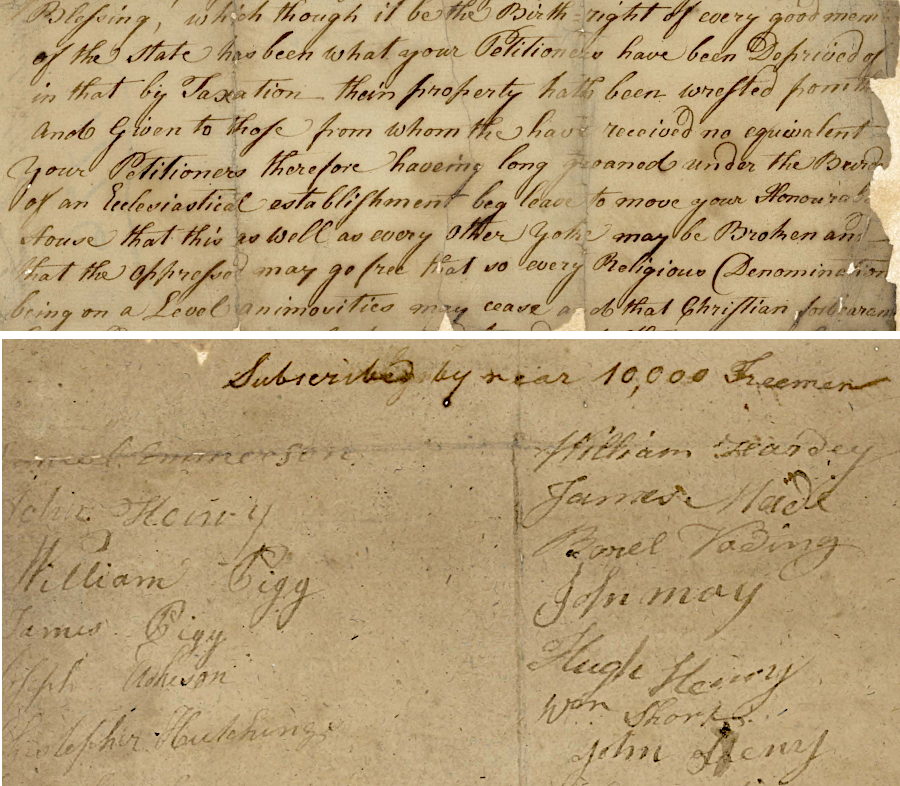
the Ten Thousand Names petition was part of the 1776 campaign by dissenters to end state-required taxation to support the established Church of England (Anglican Church)
Source: Library of Virginia, Dissenters: Petition
The governmental authority of seven local Anglican vestries were constrained in 1780. The General Assembly shifted responsibility for local social services from the vestries in seven counties to a new county-managed organization, Overseers of the Poor. That reduced the cost and time burdens on those seven Anglican vestries; they welcomed the change even though it reduced their political authority.
Also in 1780, the General Assembly authorized non-Anglican, dissenting ministers to conduct legal marriages. Since marriages determined who would control and inherit property, and children were deemed legitimate only if the parents had been wed by an Anglican minister, the right to conduct marriage rites was significant. The legislature broke the Anglican monopoly and allowed:35
The General Assembly did not place Anglican and non-Anglican ministers on equal footing in 1780. The legislature limited the right to perform marriages to just four ministers of a non-Anglican congregation within a county, and county courts had to approve the four ministers. Anglican ministers remained able to perform marriages anywhere in Virginia, but non-Anglican ministers were blocked from performing marriages outside the county in which they were registered.
The limitations may have been based not on religious discrimination, but on the need to ensure marriages were recorded officially. If a person died without a will, the county courts needed to know who should inherit property according to state law. The Anglican parishes had maintained the official marriage records during the colonial era, and parish vestries - not the local courts in each county - continued to be responsible for maintaining official marriage records.36
The general public understood the Church of England was allied officially with the King of England at the start of the American Revolution. That led to a dramatic decline in the influence of the Anglican/Episcopalian church in Virginia by 1783:37
After the Peace of Paris ended the Revolutionary War in 1783, Episcopalians sought to reinstate public funding for their churches. They petitioned the General Assembly to pass a general assessment and provide government-collected funding to a broad range of religious institutions. Advocates of a general tax argued that strengthening churches would address the disruptions in civil society created during the American Revolution, when the recriminations for violating the norms in Virginia's hierarchical society had largely disappeared.
More worship experiences, with more exhortations by ministers, would in theory lead to higher standards of "republican virtue" and better public conduct. Advocates of the general assessment argued that it would be in the public's interest to have taxes support religious "teachers."
Supporters of the traditional church described by 1783 as Episcopalians (no longer as Anglicans) expected to be the primary beneficiaries. They assumed the majority of Virginians would be counted as former Anglicans. The Episcopalians suggested that public support for the general assessment had become politically acceptable since the American Revolution had been successful, and counseled legislators that the need to mollify non-Anglican minorities during the period of actual fighting had diminished.
Dissenters were still very active in demanding fair treatment, however. They continued to petition the General Assembly, and the House of Delegates referred those petitions to an official Committee for Religion.
The Episcopalian clergy organized themselves and held a convention in Richmond starting on June 1, 1784. At the time, Methodists were still part of the Protestant Episcopal Church. They did not withdraw and establish a separate denomination until December, 1784.
On June 3, that convention submitted a formal petition to the General Assembly. It requested, among other items, that the Episcopalian parishes be released from the burden of managing social services at the local level.
In response, the Committee for Religion proposed on June 8, 1784 that the General Assembly repeal the laws directing how vestries must be chosen. That would get the government out of the business of managing the affairs of the Protestant Episcopal Church. The committee recommendation included assuring the Protestant Episcopal Church vestries that they retained ownership of their existing land, buildings, and other property.
The Committee for Religion also proposed that all denominations should be allowed to incorporate, so whatever they owned would be in the church's name. That would eliminate the need for church leaders to own church property in their personal names. That occasionally created complications when estates went though probate. Church property could be counted as personal assets, and sold to pay off personal debts of the deceased.
Another recommendation from the Committee for Religion was to relax the remaining restrictions on the rights of dissenting ministers to perform official marriages. The state legislature finally solved the problem of maintaining official records of marriages by mandating that all ministers report all marriages to the county court, which became responsible for maintain the official records.
On December 28, 1784, the Virginia legislature granted a charter incorporating the Protestant Episcopal Church. That created a legal organization which could control church property. At the time, the Protestant Episcopal Church still served as the official state church but retained few legal responsibilities different from other dnominations.38
After receiving its charter, the Church of England in Virginia was officially renamed as the Protestant Episcopal Church. The "new" denomination was legally independent from the Church of England, but reduced in scope. By the end of 1784, the Methodists had withdrawn to form their own organization.39
The bill incorporating the Protestant Episcopal Church was poorly worded. By mandating that lay leaders be included in the "Convention" to manage the corporation, the state government violated the Declaration of Rights by using government authority to impose requirements on he practices of a religious group.
Incorporation stimulated a negative reaction even within the Episcopalians, because it removed the right of vestries to select the minister. One of the petitions submitted to the General Assembly in 1785 calling for repeal of the charter highlighted the problem with mandating a Convention, which was composed of all the Episcopalian clergy plus one lay leader from each parish:40
In 1787, the General Assembly repealed the charter of the Protestant Episcopal Church. Incorporation had strengthened only one church's ability to maintain ownership of church buildings and glebes, giving an advantage to the Episcopalians in controlling its assets.
The proposed "general assessment" was one option for leveling the playing field. It would give state funding to support all the religious denominations. Throughout 1784 Patrick Henry had championed the "Bill establishing a provision for the teachers of the Christian religion." Henry proposed that dissenting religious groups as well as Episcopalians should receive tax revenue, so long as the dissenters were Christian:41
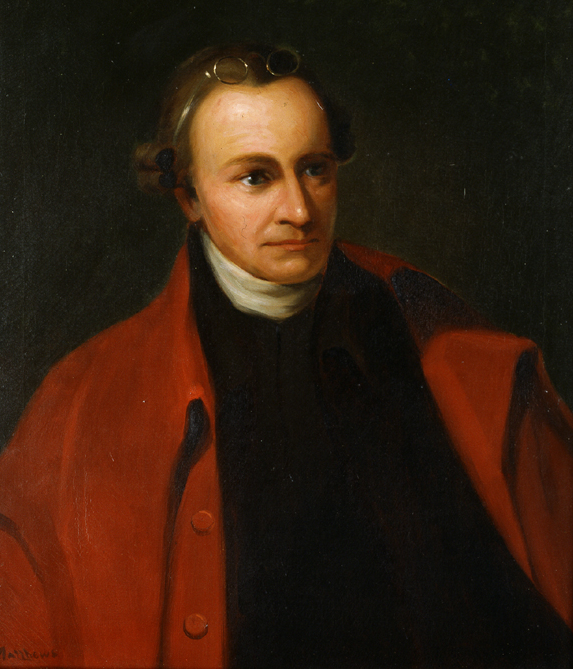
in the 1780's, Patrick Henry argued in favor of a state tax to fund churches; he did not advocate for total separation of church and state
Source: US Senate, Patrick Henry
Henry's effort to establish multiple religions, not just Episcopalians, as state-funded churches had at least tepid support initially from George Washington. While most dissenters were opposed to the general assessment bill, many Presbyterian ministers and the Presbytery of Hanover initially supported it. Those Presbyterians thought that public funding for religious institutions would enhance public order and morality and provide needed support for their religious leaders, even if such support would strengthen Episcopalians the most.
As James Madison described Henry's general assessment bill, taxpayers would have to option to direct which religious organization would receive their tax payment:42
However, the chartering of the Protestant Episcopal Church caused the Presbytery of Hanover to shift its position and oppose the general assessment bill in 1784. In the General Assembly, James Madison was able to have a vote on the tax issue delayed until 1785.
James Madison then allied with George Mason and led the charge against the bill in the House of Delegates. He published, anonymously, his Memorial and Remonstrance against Religious Assessments in June, 1785. Madison avoided personally alienating key legislators who were supporting the general assessment bill by disguising his authorship, and did not publicly acknowledge it until 1826.
In the Memorial and Remonstrance against Religious Assessments, Madison argued that religions could thrive without public funding, Due the power of their beliefs, churches could attract enough willing followers to fund church operations, including paying their ministers. Government funding was presented as a threat, an incentive to alter a church's fundamental beliefs to gain public support. Religious institutions would be corrupted by their efforts to retain public funding. In addition, giving government any power over religious organizations would lead to excessive use by elected officials of the power to shape religious decisions, in order to enhance political popularity.
Madison included in his Memorial and Remonstrance against Religious Assessments:43
As Madison agitated in the General Assembly throughout 1785, those across Virginia who opposed the general assessment bill submitted petitions against it. The opponents convinced the legislators that they were more numerous than the supporters. It helped that the powerful voice of Patrick Henry had been removed from the House of Delegates by electing him as governor.
At the end of 1785 the legislators dropped the proposed tax, the "general assessment" which Patrick Henry had championed.
Madison followed up on his victory in the debate and quickly introduced the "Statute of Religious Freedom," building on the language which Thomas Jefferson had drafted in 1777. Madison was successful in getting his bill adopted, in part because he agreed to delete Jefferson's draft preamble. It had articulated his sense of the supremacy of reason over faith:44
When the General Assembly voted on the Statute of Religious Freedom, the legislators were meeting at what is now the corner of 14th Street and Exchange Alley in Richmond. The Valentine Museum's Valentine First Freedom Center and Monument now marks the spot.
In a 66-38 preliminary vote in December 1785, the House of Delegates rejected language which would have weakened Madison's bill. As approved finally on January 16, 1786, the Virginia Statute for Religious Freedom said:45
Virginia had an official government-sponsored church not only during its colonial period from 1619-1776, but also from 1776-1786 when Virginia was a state. When the Virginia Statute for Religious Freedom was approved on January 16, 1786, it finally disestablished the Protestant Episcopal Church as the official state religion.
To replace the role of vestries in performing local social services, Overseers of the Poor were appointed in all counties. The General Assembly repealed the charter of the Protestant Episcopal Church in 1787, but all Episcopalian church property - glebes, buildings, furniture, communion plates, etc. - still remained under the control of the vestry. Dissenters were unhappy because some of the property had been donated to the parishes, but most had been acquired using government-required taxes paid by local residents who may not have shared the Anglican faith.46
Jefferson was particularly proud of his role in drafting what became the Virginia Statute for Religious Freedom. The final version had been revised during the approval process within the General Assembly, and Madison had led the political campaign to get legislative approval while Jefferson was in Paris serving as the American minister to France, but everyone recognized Jefferson's role as the original author. He included on his tombstone:47
After passage of the Virginia Statute for Religious Freedom in 1786, dissenters continued to press for the property of Episcopalian parishes acquired in the colonial period to be confiscated by the state.
The Presbyterians initiated a campaign to sell the glebes in 1787. The Baptists then took the lead. Starting in 1789, the Baptist General Committee sent a petition annually to the General Assembly requesting that the glebe lands be converted to public use. Their fundamental argument continued to be that the glebes had been purchased with taxes paid by all residents during the colonial era, and it was unfair that only Episcopalian ministers were receiving benefit from them.
Conservatives in the House of Delegates blocked annual proposals to sell the glebes. They argued that few dissenters had paid taxes to purchase the land except in counties west of the Blue Ridge, since most glebes had been acquired before 1750. Until then, nearly everyone east of the mountains was an Anglican, except for some Quakers.
In 1796, the French Revolution created a stronger push for change in Virginia. The Episcopalians calculated they finally would lose a vote in the state legislature, so they sought to have a court decision to resolve the status of their claims to the glebes. Transferring the issue to the judicial branch was not successful.
On January 24, 1799, the General Assembly repealed seven previous acts which were perceived as inconsistent with the Bill of Rights, because they mixed government and ecclesiastical authority or provided undue support to one denomination.
The laws were repealed because they:48
Primary reason for the repeal was to eliminate the 1776 guarantee that Anglican church property would remain under the control of vestries. The 1799 law repealed "An act for exempting the different societies of Dissenters from contributing to the support and maintenance of the church as by law established, and its ministers, and for other purposes therein mentioned," which had protected vestry rights to property when passed on November 19, 1776.
For the next two years, there were discussions on how to sell the glebes - including land, enslaved workers raising crops and livestock, and the buildings in which ministers lived - and what to do with the money. In 1802, the General Assembly passed the "Act Concerning the Glebe Lands and Churches within this Commonwealth." It authorized the sale of glebe lands upon the death or resignation of the current rector (minister) of a parish in the Protestant Episcopal Church. The requirement that the pulpit be empty avoided pushing a minister out of their home while they were still actively preaching and had a group of supporters in the community.
Proceeds from the sales were delivered to the Overseers of the Poor in that county, for establishing and supporting local academies for public education, and to reduce taxes. There were some cases where individuals took advantage of the sales for their personal benefit, such as using the land after the death of a minister until the sale was completed but not paying any rent.
Only the glebes were confiscated; Episcopalians retained the buildings in which they worshipped The General Assembly was less ambitious than Henry VIII, who had seized the church monasteries and other buildings 250 years earlier. The legal justification for selling the glebes in Virginia was equally strong for seizing the church buildings and the land on which they sat, but that would have displaced worshippers. Selling just the glebes offered the best opportunity to get a one-time cash windfall in many counties, while minimizing political opposition.
The 1802 law specified:49
Where a congregation of Episcopalians was using a church building, it typically stayed under their control. Where the congregation had dissolved, abandoned Anglican churches simply decayed away without maintenance. Rather than try to occupy old Anglican churches, Baptists, Presbyterians, Methodists and other religious groups typically built their own houses of worship at convenient locations for their followers.
There were exceptions. In one case, an old Anglican church building was sold to the highest bidder. In Prince Edward County, both the Methodists and Baptists sought to control an old church. The Baptists ended up with the title, but allowed the Methodists to use the building. In Williamsburg, the Bruton church was used by different congregations until 1831:50
Episcopalians sought to block the sale of their glebes, and almost succeeded. In 1803, the vestry of Manchester Parish in Chesterfield County won the Turpin v. Locket lawsuit to block the overseers of the poor from selling its glebe. The Virginia Supreme Court of Appeals was prepared to issue its 3-1 ruling that the 1802 law was unconstitutional. However, Chief Justice Edmund Pendleton, who had voted in the majority, died the day before he was planning to announce the opinion.
His death triggered a rehearing of the case. In 1804, the newly-appointed member of the court concluded that the 1802 law was constitutional. According to the rules of the court, the resulting 2-2 tie meant the law was left in place rather than overturned. As a result, most glebes eventually were seized and sold. Some of the initial funding for the University of Virginia came from the sale of two glebes.51
The Staunton Academy received some funding from sale of the glebe in Augusta County. The Anglican church there had been unable to get General Assembly authority to sell the glebe in 1773. Eventually, the land was sold - but the revenue was not provided to the Episcopal Church as the successor to the Church of England.
The Code of Virginia still includes:53
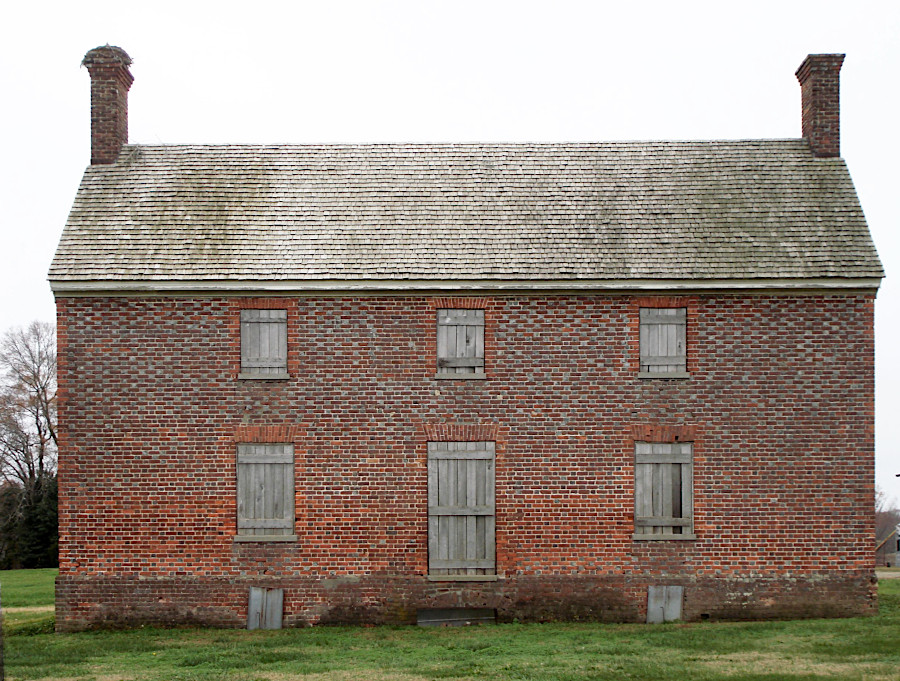
the glebe of St. Anne's Parish in Essex County was sold in 1803, including the brick glebe house
Source: National Register of Historic Places, 028-0014 Glebe House of St. Anne's Parish
Not all glebes were lost by the Episcopalians. In 1817 the vestry of Bennett's Creek Church in the Suffolk Parish, located in what is now the City of Suffolk, won a lawsuit that protected their ownership of a glebe. The church successfully argued that the property had been donated rather than purchased, and was therefore exempt from seizure.53
The last glebe transferred to Overseers of the Poor under the 1802 law was in Loudoun County. The vestry of Shelburne Parish acquired their 465-acre glebe in 1773. The parish was created in 1769, and initially had to pay its minister a higher-than-average salary because there was no glebe income. After the 1802 law was passed, the parish vestry managed to delay the seizure of their glebe for nearly 40 years.
The 1840 Virginia Court of Appeals ruling in Selden v. Overseers of the Poor of Loudoun again declared the 1802 law to be constitutional, but based that conclusion on the principal of Stare Decisis.
The glebe house, now expanded significantly, still stands. In 1981, drug lords later described as the "Rockefellers of the marijuana business" purchased the glebe house and 675 acres around it for $1.7 million, paying in cash. The Federal government infiltrated the multi-million dollar operation selling tons of marijuana and hashish, and seized the property in 1985.
The Federal government later sold the seized property. In 2023, the glebe house and 230 acres came back on the market priced at $3.875 million.54
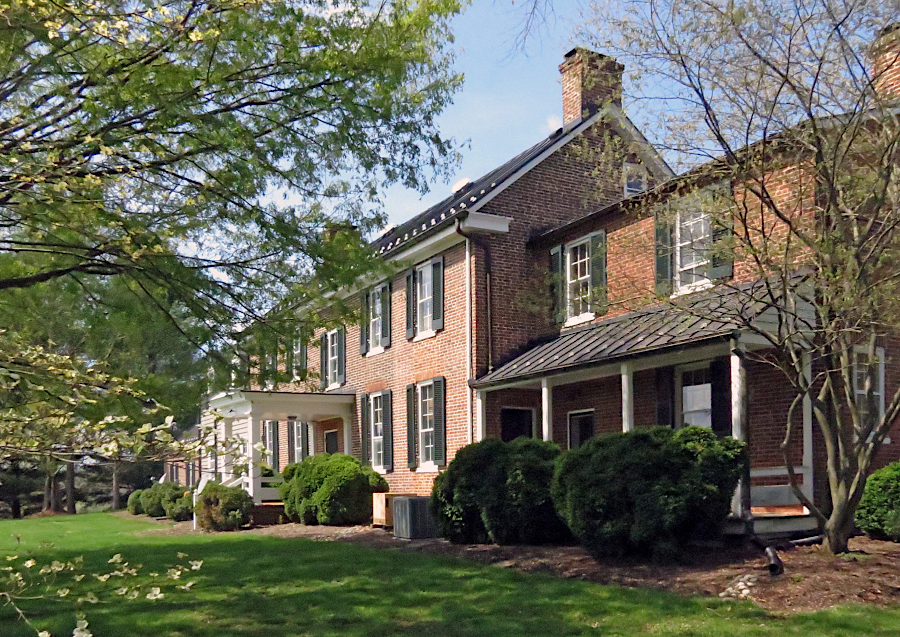
the glebe house of Shelburne Parish was enlarged after finally being sold to a private owner in 1840
Source: National Register of Historic Places, 053-0186 Glebe of Shelburne Parish
The Fairfax Parish also protected its glebe. That parish, created in 1765, paid its first minister a salary of 17,280 pounds of tobacco. It added an additional allowance of 2,500 pounds because it also had no glebe, until the vestry purchased the plantation of Daniel Jennings in 1770. The vestry paid 15 shillings per acre for what was thought to be 400 acres, but an 1815 survey revealed the total was 566 acres.
The Fairfax Parish vestry also ordered construction of a new 1.5 story brick glebe house, which was completed in 1775 and became the minister's home. In what is now Arlington County, Glebe Road connected the glebes of the Falls Church and Christ Church.
When Virginia ceded territory to create the District of Columbia, the glebe for Fairfax Parish ended up in the new district's Alexandria County. The Fairfax County Overseers of the Poor tried to force the sale of the glebe in 1811, claiming the glebe had been owned by the state government since 1776. The vestry argued that seizure was not authorized because the property was in the District of Columbia rather than the Commonwealth of Virginia.
The US Supreme Court ruled in favor of the vestry of Fairfax Parish in 1815. The Federal Court declared in Terrett v. Taylor that the glebe was the private property of the Protestant Episcopal Church. The state law incorporating the church in 1784 made it unconstitutional to seize the glebe later, under the 1802 "Act Concerning the Glebe Lands and Churches within this Commonwealth." By 1815, however, all but the Shelburne Glebe in Loudoun County had been acquired by Overseers of the Poor in different counties.
The Fairfax Parish had the unique ability to sue in Federal court because its glebe was in the District of Columbia. In 1815, a declaration by the US Supreme Court that a Virginia state law was unconstitutional did not have the same effect as it would today. The 1803 tie vote in the Virginia Supreme Court of Appeals had established that, in Virginia courts, the General Assembly's 1802 law was consistent with the Virginia constitution. The US Supreme Court decision would affect Federal cases, but the Shelburne Glebe case did not become a Federal lawsuit in which Terrett v. Taylor would be a controlling precedent.
Over 90 glebes were transferred to Overseers of the Poor, and the Fairfax Parish was the only one to defeat the 1802 law and avoid losing its asset. In the end:55
In parishes where the minister had died and left and no services were being held, the General Assembly authorized use of the empty church buildings for school academies. In King George County, the legislature passed a law in 1808 that permitted an academy to use the brick church which had been constructed in 1766, and also authorized sale of the glebe lands to fund reconfiguration of that building.
By 1816 the academy had failed and the Episcopalians had regrouped. They successfully petitioned the General Assembly to return the building for their use. St. Paul's Episcopal Church continues to this day to meet there.56
In a unique case, the glebe of Hungar's Parish on the Eastern Shore was sold in 1850 over objections by the vestry. The glebe had been donated though a will written in 1654, with a provision that a minister must preach there regularly. If the pulpit was vacant for six months, the land would revert back to a descendant of the donor. In 1835, the Overseers of the Poor in Northampton County sought to force the sale of the glebe. The Overseers claimed the property had escheated to the state, because the current Episcopal Church had a different doctrine than the Anglican parish which was in existence in 1654.
The vestry argued that fundamental doctrine was consistent, though liturgical practices had changed after the American Revolution. The Overseers pressed their case by contracting to sell the property. In 1842, the vestry won a lawsuit against the buyer that re-affirmed the vestry's ownership. The Virginia court determined that the buyer had not acquired title to the glebe, but another lawsuit filed in 1846 continued the dispute.
In 1859, the Overseers claimed that there had been a gap between ministers of greater than six months, and thus according to the 1654 will the parish was no longer the owner of the glebe. The highest court of Virginia, the Court of Appeals, ruled in favor of the Overseers of the Poor. That final decision was based on the court's interpretation of the will; the 1802 "Act Concerning the Glebe Lands and Churches within this Commonwealth" turned out to be irrelevant.
The disruption of the Civil War delayed action by the Overseers of the Poor. The glebe of Hungars Parish, the last to be converted to public property, was finally divided into three sections and sold to private owners in 1870.
In addition to the glebe funded by tax dollars for the Anglican St. John's Parish in Hanover County, there was also a Presbyterian glebe. Evidently 300 acres were purchased by 1751 by contributions from Presbyterians next to Totopotomoy Creek near modern-day Pearson's Corner on Route 301. The glebe was for the support of the Rev. Samuel Davies of Polegreen Church. After Rev. Davies died, either his estate or the Presbyterians sold the property. Because it was acquired as a private purchase which did not use public funds, the ownership and sale of the Dissenters Glebe was not affected by the disestablishment of the Anglican Church.57
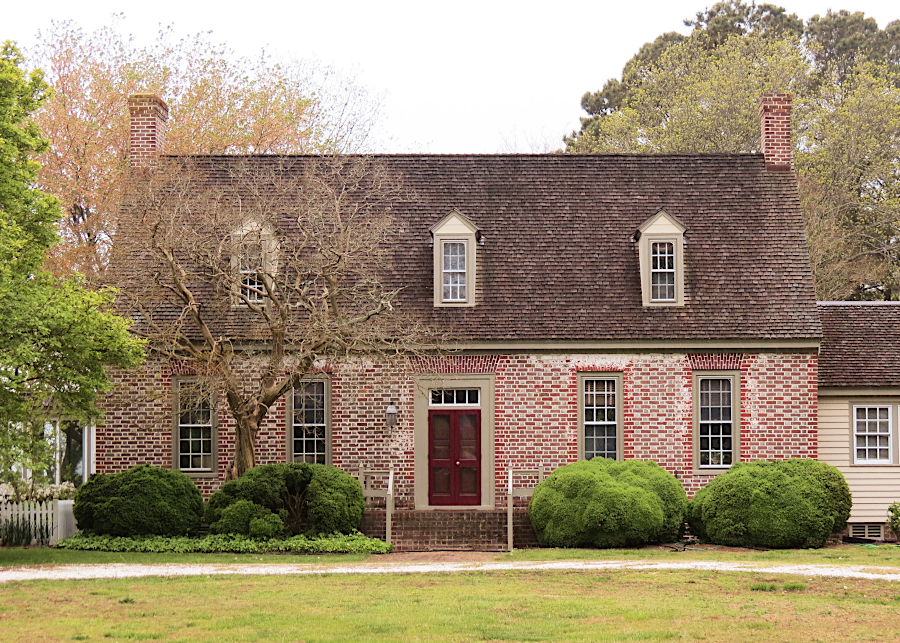
the Overseers of the Poor in Northampton County acquired the glebe of Hungars Parish through a unique legal argument, not through the 1802 law authorizing sale of glebes
Source: Virginia Department of Historic Resources, 065-0033 Glebe of Hungars Parish (by David Edwards/DHR, 2021)
When Alexis de Tocqueville visited the United States in 1831-32, he discovered to his surprise that individual faith and religious institutions were thriving without government support. As a Catholic, he was especially interested in how those priests viewed the separation of church and state. He concluded that religion was more vital to the Americans than the French because it was freely chosen, creating a stronger personal commitment:58
The Continental Congress, the Confederation Congress, and then the US Congress had no opportunity to select any particular faith as the one established religion; there were too many different religious institutions and no dominant faith across all 13 colonies/states. However, the legislators still sought to find ways to use national assets to support religion.
When the Confederation Congress originally drafted the Land Ordinance of 1785, it planned to dedicate a tract of land in each surveyed township "for the support of religion," along with an equal amount of land "for the maintenance of public Schools," and directed that:59
That provision avoided defining which church would receive the revenue from the land dedicated "for the support of religion." Residents in each township would make that decision, and different townships might choose to fund different denominations.
During the second reading of the bill, as the Confederation Congress debated the draft of the ordinance, 12 of the 13 colonies had representatives in attendance. Only New Jersey was missing when a member from New York made a motion to strike out "and the section to religion."
In the final 17-6 vote, Rhode Island and Maryland supported retaining the wording while representatives from New York and North Carolina split their vote. All the other states voted in the majority to remove the language. If the words had stayed in the ordinance, the national government would have officially supported religion in a generic manner comparable to Patrick Henry's general assessment proposal.60
Four years after deleting the clause from the bill which finally became the Land Ordinance of 1785, the Confederation Congress included just a generic statement about religion in the 1787 Northwest Ordinance. In 1787, the members in the Confederation Congress again prioritized education instead of religion:61
Two land sales in 1787 did provide specific support for religion. The sale of 1.5 million acres to the Ohio Company of Associates and the sale of one million acres to John Cleve Symmes required the purchasers to divide up parcels for sale using the rectangular survey system, and also required that the purchasers dedicate the land in Section 29 to "the purposes of religion." That mandate echoed the proposal to dedicate a portion of national government land sales "for the support of religion" which had been considered, but then rejected, in the drafting of the Land Ordinance of 1785.
The Ohio Company of Associates was a group of land speculators totally different from the earlier Ohio Company that had obtained a 500,000 acre grant from colonial Virginia's General Assembly in 1749. Virginia's cession of the Northwest Territory had ended the potential for that group to acquire land.
The Ohio Company of Associates was composed of 285 officers who had served during the American Revolution and were willing to pay for western lands, since it did not appear that the Congress would award them land grants for their service. They agreed to pay $1 million for the land. In the end, the Ohio Company of Associates used Continental securities which had been acquired at a significant discount to reduce the actual purchase cost.
From the beginning of the effort by the Ohio Company of Associates, religion was used to help justify the government selling such a large swath of land. The key leader in the Ohio Company of Associates sent a letter to George Washington in 1783 and got his endorsement. The letter included the plan to divide the land into:62
The Confederation Congress authorized the sale to the Ohio Company of Associates on July 23, 1787. The pressure to dedicate Section 29 "for the support of religion" came from the Ohio Company of Associates rather than from the Continental Congress. Reverend Manasseh Cutler, another key leader in the company, made the desire clear. Having a minister in the newly-settled land was expected to improve social behavior in a place on the frontier, and revenue from Section 29 would support a minister. From an economic rather than a social perspective, making the township a more stable community would help attract more purchasers of land.
The Confederation Congress commitment to sell 1,000,000 acres to Judge John Cleves Symmes was approved on October 2, 1787. The two sale agreements were made when the national government was still operating under the Articles of Confederation, a year before ratification of the new US Constitution and four years prior to ratification of the First Amendment in the Bill of Rights.
A second sale was authorized by the US Congress in 1792 to members of the Ohio Company of Associates. That sale authorized the use of army bounty warrants for purchase, and the requirement for use of Section 29 to support religion in the "Second Purchase" was omitted. The company still chose to dedicate Section 29 for that purpose. In Ohio, about 43,500 acres in different Section 29 parcels are known as the "ministerial lands."
Trustees managing the ministerial lands leased them to generate income. The sections dedicated to support education were also leased. In the early 1800's, the trustees decided to sell rather than perpetually lease those acres. The cash from selling the land would be deposited into a permanent endowment managed by the State of Ohio.
Selling the land required obtaining clear title. The United States had retained official ownership of Section 29 lands since 1787. The national government had not transferred those sections to the Ohio Company of Associates for the "First Purchase" or for the land sold under the arrangement with Judge John Cleves Symmes.
The US Congress passed acts as needed to transfer title to the State of Ohio. By 1918 the "ministerial trust fund" managed by the state was worth $150 million. The revenue was distributed to religious societies within Ohio based upon the percentage of membership until 1968. Ohio voters approved an amendment to the state constitution then so all future revenue would be used just for educational purposes.63
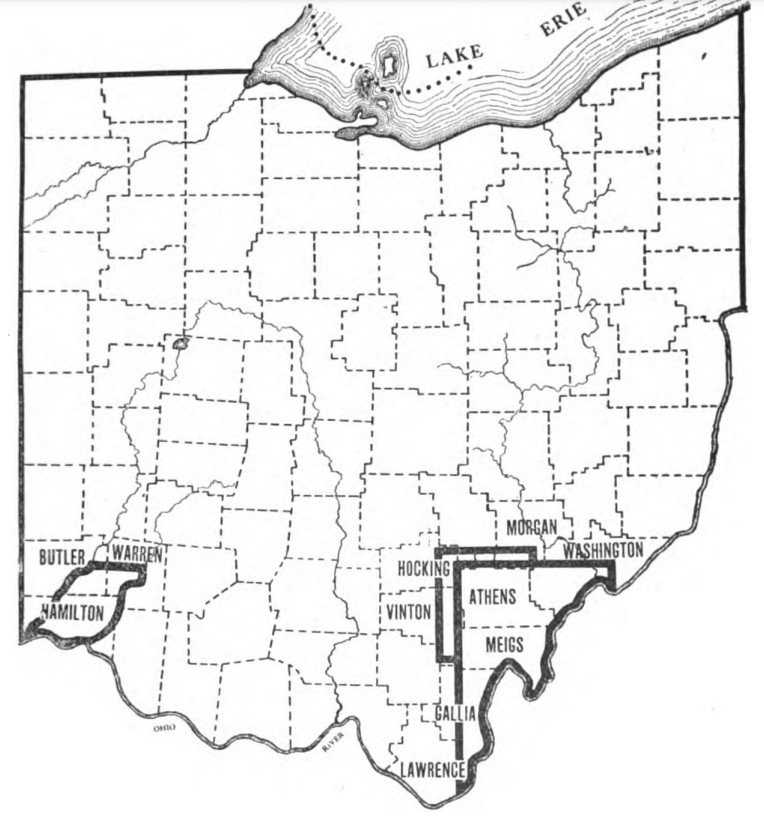
two land sales by the Continental Congress in 1787 required using Section 29 for the purposes of religion
Source: William Edwards Peters, Ohio Lands and Their Subdivision
The US Constitution, written in the 1787 Constitutional Convention to replace the Articles of Confederation, included no clear statement regarding religious liberty other than Article VI. The US Constitution did not block Catholics from being elected to Federal offices, an omission unlike most state constitutions at the time.
Everyone at the Constitutional Convention in 1787 except for the Virginia delegates came from a state with religious tests restricting who could serve in public offices. The delegates representing so many diverse populations could not agree on a standardized Federal religious test. Different states would discriminate in different ways, allowing different "dissidents" to serve.
Article VI of the US Constitution was written to say:64
However, after ratification in 1789 the US Constitution imposed no restriction on the 13 states imposing a religious test. Some survived for decades, and Maryland blocked atheists from becoming a notary public until 1961. A US Supreme Court ruling in 1961 finally ended that religious discrimination.65
When drafted in 1787, the proposed Constitution failed to articulate clearly the rights retained by individuals and states. That omission threatened ratification of the new form of government by the 13 states. During the ratification debates in Virginia, James Madison promised to amend the Constitution to make clear the constraints on the Federal government.
In the First Congress (1789-90), James Madison successfully led the first effort to amend the US Constitution. He fulfilled the promises he had made in the Virginia ratification convention, and included a restriction on Federal authority to support religion in the First Amendment:66
The ten amendments that became the Bill of Rights limited the power of just the Federal government to interfere with religious freedom. The First Amendment did not apply to the states until the Supreme Court ruling in the Cantwell v. Connecticut case in 1940. State laws passed by the Virginia General Assembly, not laws passed by the US Congress or court decisions based on the US Constitution, caused Virginia to stop providing state funding to churches, to disestablish the Protestant Episcopal Church of Virginia, and to confiscate the glebes.
Today, the US Supreme Court has determined that the states must also comply with the Bill of Rights. In 1962, the court determined in Engel v. Vitale that official classroom prayers in public schools violated the First Amendment, and that the Fourteenth Amendment required state governments to meet the same standards as the Federal government. Government agencies at all levels today are required to treat religious belief as a permanent natural right, based on the First Amendment ("Congress shall make no law respecting an establishment of religion, or prohibiting the free exercise thereof...).
The adoption of the First Amendment does preclude the Federal government from providing public support for institutions which have a religious character at least in part. Interpretation of the restrictions on public support for religion continue to trigger legal cases that reach the US Supreme Court for decisions.
In 1879, the US Supreme Court ruled in Reynolds v. United States that the Federal government could not mandate any religious beliefs, but it could control behavior based on those beliefs. The case affirmed that government was empowered to outlaw polygamy, even though a member of the Church of Jesus Christ of Latter-day Saints held a religious belief that his faith required marrying multiple wives.
Government limits on behavior must have a compelling governmental interest, but the justices in 1879 decided that authorizing any and all behaviors based on personal religious belief would be too constraining. Allowing exemoptions to laws based on personal religious beliefs would "permit every citizen to become a law unto himself." Government could limit expression of religious beliefs, such as human sacrifices as part of religious worship, because:67
In addition to the words in the US Constitution and various laws, many cases cite language about maintaining a "wall of separation" between church and state. When the US Supreme Court cited those words in Reynolds v. United States in 1879, the phrase was called an "authoritative declaration of the scope and effect" of the First Amendment language.
Thomas Jefferson had penned the phrase in 1802. He explained in a letter to the Danbury Baptist Association that he had declined to issue a proclamation recommending a general thanksgiving, after learning the France and the United States had agreed to a treaty eliminating the threat of war. Jefferson had opposed the practice of Federalist officials to invoke a religious basis for their actions.
In 1777, he had endorsed Bill No. 85, a "Bill for Appointing Days of Public Fasting and Thanksgiving." However, that was 15 years earlier and before the creation of a Federal government based on a US Constitution.
Jefferson wrote to the Baptists in Danbury, Connecticut:68
In 1830, Virginia voters approved a replacement for the 1776 state constitution. In Article III, Section 11, the second Constitution of Virginia provided a clear statement regarding the limits on state power regarding religion:69
After 1784, the General Assembly had refused to incorporate any religious denominations. Because churches were not legally chartered, they lacked clear title to the land and property with their buildings for worship. In addition, members of a church could not include a bequest in their wills to churches. Without a charter, churches were not a "body" that existed in the eyes of the law.
In 1815, the General Assembly refused a request by Presbyterians to incorporate a new theological seminary. The Presbyterians bypassed that rejection by having the seminary and its endowment managed through the denomination's own General Assembly, and that organization was incorporated by the State of Pennsylvania.
As one scholar has noted, Jefferson and Madison would have been surprised at how their ideals and words abut religious liberty were used by Virginia's later leaders to oppress organized religion:70
In 1787, when the General Assembly repealed its incorporation of the Protestant Episcopal Church in 1784, the law had authorized the church to own its land, buildings, and other property. However, the 1799 repeal of all laws related to religion, other than the 1786 Virginia Statute for Religious Freedom, removed this right.
In 1842, the state legislature finally authorized religious denominations to own a limited amount of property. A church could legally own up to two acres of land in a city or town, and up to 75 acres of land in the countryside. Virginia's state legislature still refused to authorize incorporation by religious organizations.
The 1842 law finally clarified that churches could have clear title to their land, but only in a roundabout way. Land could be owned by individual members or by trustees, but not held in the name of the congregation. Without the authority to incorporate, congregations still were not recognized officially by law. The limitation on property ownership was justified by a desire to prevent any religious group from becoming wealthy and powerful, as the Catholic Church had done in Europe.
Congregations who elected trustees were required to have them officially appointed by local courts. The role of the trustees, and the requirement of the local court to approve selling our purchasing property, limited the powers of a minister, bishop or Catholic priest in hierarchical denominations where local congregations did not choose its leadership. In Virginia, the system ensured that lay leaders would not be threatened by a religious leader who might establish independent authority and potentially preach against slavery.
Different denominations were constantly on guard against any one gaining special privileges from the General Assembly. In the early 1800's, efforts by Baptist and Episcopal ministers to authorize churches to incorporate were blocked by Presbyterian opposition. The prohibition was incorporated in the 1851 constitution:71
The General Assembly approved a ballot measure in 1996 that would have changed the state constitution and allowed religious societies to incorporate. Voters approved four other ballot measures in 1996, but rejected the proposal for church incorporation.72
Until 2002, religious institutions had to appoint trustees to manage their property. Circuit Courts had to approve the appointments of new trustees, and also had to approve real estate transactions. The 1842 limits on property ownership had been increased over the years until, in 2002, the caps were 15 acres of land in a city/town or 250 acres outside city/town boundaries within a single county. Cities and towns were authorized to allow up to 50 acres.
There was also a limit on how much religious societies could own in assets other than real estate, such as stocks and bonds. The limit set in 1842 was $30,000; by 2002, the cap was $10,000,000 in personal property. There were no equivalent limits on secular organizations.
The Thomas Road Baptist Church, led by Rev. Jerry Fallwell, was blocked by state law from owning the land where it was building a new facility on 60 acres in Lynchburg. It sued the State Corporation Commission, claiming that the state agency's refusal to incorporate the church was a violation of the US Constitution. The American Civil Liberties Union (ACLU) supported the church's lawsuit. The state did not defend the law; it only claimed that the issue was moot because the church had not been harmed.
On April 15 2002, Judge Norman K. Moon of the US District Court for the Western District of Virginia ruled in Falwell v. Miller that the state constitution violated the First Amendment. After that decision, the State Corporation Commission has allowed religious denominations to incorporate and caps on property ownership have been eliminated.73
Since 1776, the Commonwealth of Virginia has always prioritized the Christian faith over others.
As mentioned above, at the start of the 1901-1902 constitutional convention John Garland Pollard proposed deleting the word "Christian" from Section 18 of the Bill of Rights in the 1870 Constitution, which included wording as originally adopted in 1776 (emphasis added):74
The proposal was intended to make more clear that the state constitution was a secular document, and that religious equality should not prioritize forbearance of others by the faith of the majority. Pollard viewed the separation of church and state as placing each religion upon equal footing in the eyes of the law, rather than assuming Virginia was a "Christian state" in which other religions would be authorized through the tolerance of Christians.75
Pollard argued that state government should not be evaluating whether one religion was better than another. Toleration could be revoked; constraints on followers of minority religions could be created. If religious liberty was the standard rather than toleration, then legal equality across all faiths would limit the ability of the majority to impose extra burdens upon members of minority religions.
The proposed modification of the Bill of Rights in 1902 was welcomed by the Jewish leadership within Virginia, but evangelical Christian leaders objected. Though Pollard might have been able to convince the members of the constitutional convention that the change was appropriate, he accepted advice that the change would be unpopular among the voters and might threaten ratification. Disenfranchising black voters was a higher priority than making a statement about religious equality, and Pollard dropped his proposal.
In the end, the 1902 Constitution was never submitted to the voters for ratification. The constitutional convention just declared that it would replace the existing state constitution, so the concern about voter opposition turned out to be a solid basis for Pollard dropping his proposal.
The 1901-1902 constitutional convention also rejected an effort to elevate into the state constitution the existing state law restricting how much property a religious institution could own. Elevating that restriction was linked to a proposal to allow churches to incorporate. Denominational agencies, such as a relief organization, already could incorporate under an interpretation by Virginia courts of the state constitution. However, the sponsoring religious denomination could not get a corporate charter from the General Assembly. In contrast, 43 of the 46 states allowed churches to incorporate just like breweries and baseball clubs.
The constitutional limit on real estate ownership proposed in 1902 was expected to prevent churches from becoming too wealthy and too powerful. That concern was based largely on how Protestants interpreted the history of the Roman Catholic church. Carter Glass, a delegate to the convention who later served as US Senator, responded that the appropriate response to fear of a wealthy church was to incorporate and then tax all churches.
When the restriction on property ownership by a religious denomination was defeated in the convention, the 1902 proposal to authorize incorporation was also dropped.
The new 1902 constitution did end the practice of Virginia cities funding private charitable institutions that performed essential services, such as providing housing for orphans. Leaders of the Baptists and Methodists led the effort to end local funding for institutions in Richmond, Norfolk, and a few other cities that, in most cases, were associated with the Roman Catholic Church. City officials said the hospitals, asylums, and homes for the aged were non-sectarian and church support helped to subsidize the costs. Protestants claimed that enhancing any religious institution would inevitably enhance the denomination associated with it.
The logical argument that that public funds should support only public institutions was amplified by anti-Catholic bias, with references to religious rivalries in medieval history. The proponents of a ban on public funding for any religious institution glossed over the recent request from Methodists for 35 acres of land from the city of Lynchburg to facilitate construction of an orphanage run by that denomination - an orphanage recently incorporated by the General Assembly.
One member of the 1901-1902 convention proposed that if complete separation of church and state was necessary, then tax exemptions on churches should also be ended. The state should drop its "blue laws" that required retail establishments to close on Sundays, which was the Sabbath for Christian denominations but not for all faiths. Those proposals did not advance, and state support for Protestant denominations was even increased by adding parsonages to the list of church property that would be tax exempt. That change benefitted primarily rural Christian churches; urban churches typically did not provide free housing for their ministers.
The prohibition on public funding for religious institutions providing public services was included in the 1902 state constitution. Afterwards, Richmond and Norfolk had to appropriate more funding to continue to operate their charitable facilities without assistance from the religious groups. The new constitution's Article III, Section 67 ban on funding non-public institutions also led to William and Mary College becoming a 100% state institution in 1906.76
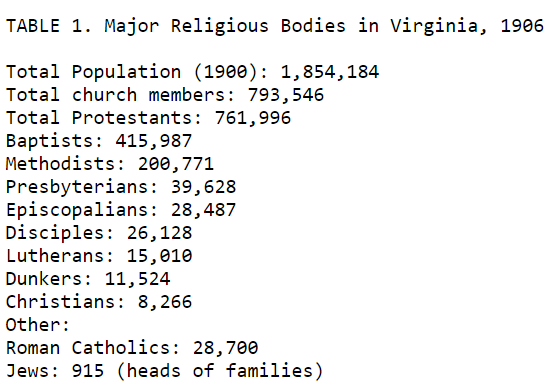
though the percentage of Roman Catholics in Virginia was low, decisions at the 1902 constitutional convention reflected Protestant fears of that faith
Source: Thomas E. Buckley, S. J., "A great religious octopus": church and state at Virginia's Constitutional Convention, 1901-1902
Restrictions on discrimination by government agencies does not prevent religious discrimination by individuals. In the 1928 election, Virginia voted for a Republican presidential candidate for the first time since 1872. Al Smith, the Democratic candidate, was both a Catholic and opposed to Prohibition. The Republican candidate, Herbert Hoover, benefitted from a wave of economic prosperity.
Protestant leaders such as Methodist Bishop James Cannon, a leader of the Virginia Anti-Saloon League, openly opposed Smith's election. Voters gave Herbert Hoover a majority in 40 of the 48 states in 1928. Al Smith believed that religious prejudice was a major reason for his loss.
Nancy Astor, a native of Virginia and the first woman elected to serve in the English Parliament, publicly expressed the anti-Catholic bias of the Virginia elite. She said Hitler's Germany was entitled to rearm before World War II because it was "surrounded by Catholics."77
Virginia voted for two Catholic presidential candidates in 1960 (John F. Kennedy) and 2020 (Joe Biden), and elected its first Catholic governor (Tim Kaine) in 2005. Open religious prejudice today is focused primarily against Muslims and Jews.
Anti-Jewish sentiment comes from individuals and non-government organizations; overt religious discrimination by government agencies against Jewish groups is now rare in Virginia. The remaining prejudice by non-government groups was reflected in the "we will not be replaced" chant during a 2017 white power rally with tiki torches in Charlottesville.
In late 2022, public reaction was strong when a chapter of the After School Satan Club planned to open at an elementary school in the City of Chesapeake. The nationwide club had been created in response to Christian proselytizing through the Good News Club, and a chapter of that club had been organized recently at B.M. Williams Primary School.
Though the After School Satan Club stated it did not believe in Satan and instead was using his name to stand up to tyrannical authority, people drove from 100 miles away to express their opposition to the club at a meeting of the city's school board. The public comment session lasted over three hours, with 68 people signed up to speak. Opponents to authorizing the club read Bible verses as they asked a government agency to block what was viewed as a religious program of dissenters.
Lawyers in the ACLU Program on Freedom of Religion and Belief represented The Satanic Temple, which was intentionally provocative in order to highlight that religious freedom was not limited to advocates of traditional religious beliefs. The school board was forced to make facilities available on equal footing, and in the end could not impose a security fee on just the After School Satan Club. Nine children met on February 16, 2023, and made crafts as they socialized.
There were protestors outside the school building at the start of the first meeting of the After School Satan Club. The school system used its own funds to hire private security. There were no incidents on the day of the first meeting, but an e-mail bomb threat the following week which referenced "devil worship" forced early dismissal one afternoon.
The school superintendent in Chesapeake had notified parents before the first meeting that:78
In 2023, the Chesapeake School Board debated its facilities use policy. It first limited use of school buildings by external groups to 6:00-10:00pm, impacting after school meetings, except for school-sponsored or school-affiliated groups and government entities. After eight months of discussion, the school board rejected proposals to prohibit all non-school clubs and organizations from using school facilities. That proposal would have excluded the After School Satan Club, but also many other local groups - including the Good News Club and the Girl Scouts.
To emphasize the requirement that government agencies may not discriminate based on religion, including atheists, the After School Satan Club hosted a movie night at Jefferson Forest High School in Lynchburg on February 25, 2023. The group sold 125 tickets to watch a 1992 G-rated movie, "FernGully: The Last Rainforest." A campaign director for the After School Satan Club told the local newspaper:79
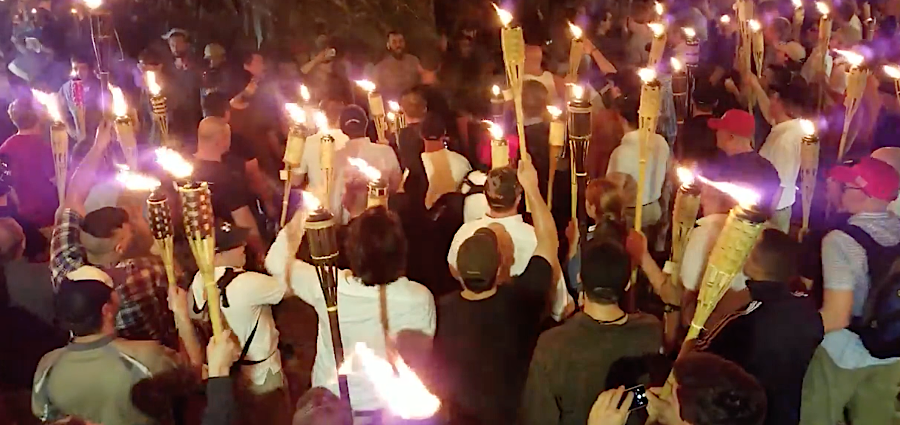
modern anti-Jewish bigotry was displayed with a "you will not replace us chant" at a 2017 white nationalist rally in Charlottesville
Source: Southern Poverty Law Center, When white nationalists chant their weird slogans, what do they mean?
Zoning decisions by local governments have reflected anti-Muslim prejudice. Mosques have relied upon lawsuits and the courts to obtain equal treatment. In 2016, the US Department of Justice filed a lawsuit against Culpeper County after it denied permission for the Islamic Center of Culpeper to pump and haul away sewage from a planned new mosque location in a rural area without any connection to a wastewater treatment plant. Local residents had expressed unjustified concerns about Islamist terrorism.
Other organizations and businesses had been granted pump and haul permits in similar situations. A Culpeper County supervisor was unhappy when the county settled the lawsuit in 2017 and authorized the permit, rather than mandate installation of a septic system that would cost the 20 members of the Islamic Center of Culpeper between $20,000 and $25,000. The elected official argued that the county's decision was based on appropriate land use regulations for undeveloped land, not any religious discrimination which violated the Federal Religious Land Use and Institutionalized Persons Act of 2000:80
The US Department of Justice also filed a religious discrimination lawsuit against Stafford County in 2020. The local supervisors had adopted land use restrictions in 2016 which effectively blocked the All Muslim Association of America from opening a new cemetery sized for 15,000 graves, while imposing looser restrictions on Christian cemeteries. The Federal government claimed that Stafford County had violated the Religious Land Use and Institutionalized Persons Act. The county rescinded the ordinance and paid $500,000 to the All Muslim Association of America, settling the lawsuit before trial.81
After the terrorist attacks on September 11, 2001, anti-Muslim sentiment has often conflated all Muslim groups with violent acts by a relatively small number of religious extremists. In 2014, a former deputy national security adviser for Middle East policy at a religious conference said he objected to President George W. Bush saying that Islam was a religion of peace. A fellow attendee challenged that religious bigotry, and responded:82
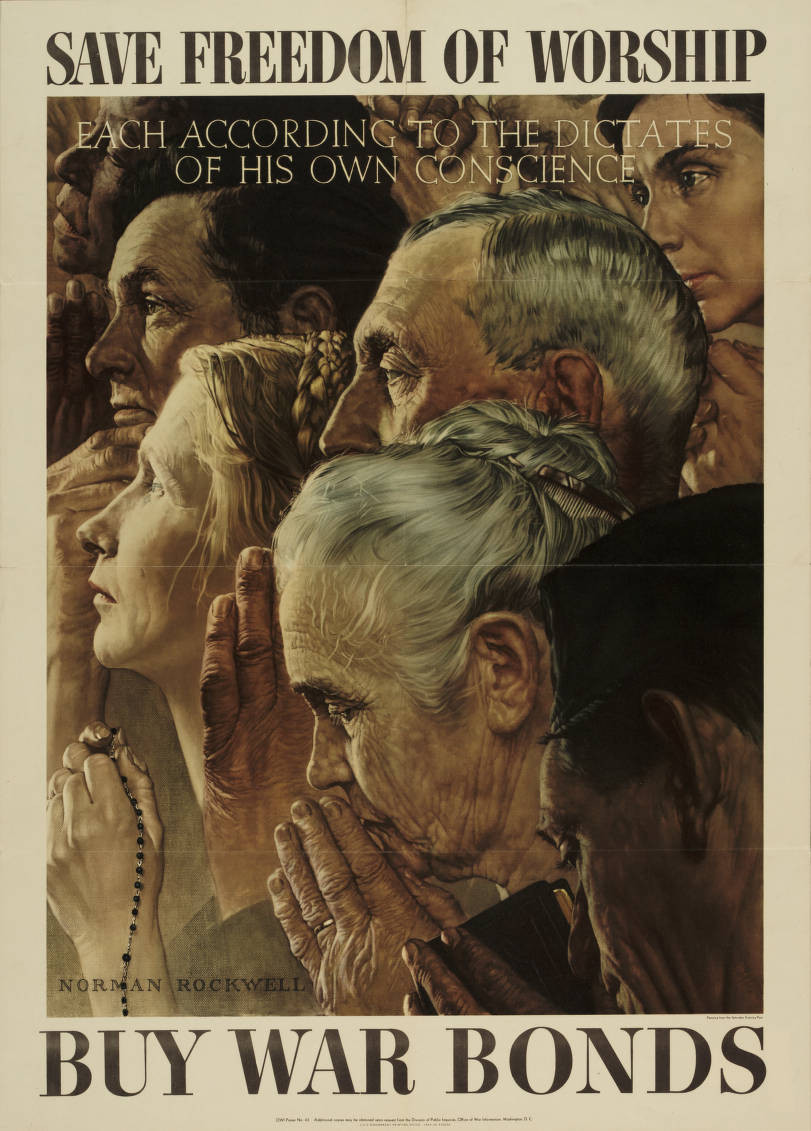
President Franklin D. Roosevelt highlighted freedom of worship as one of Four Freedoms in his 1941 State of the Union Address
Source: Penn State University Libraries, Save freedom of worship : each according to the dictates of his own conscience: buy war bonds (by Norman Rockwell, 1943)
In 1978, the US Congress passed the American Indian Religious Freedom Act. It was intended to increase access by Native Americans to sacred sites, and to limit interference by local, state, and Federal officials with traditional religious services. After some Virginia tribes were granted Federal recognition, there is greater potential for a court case that tests the boundaries of that protection against other laws that limit certain behaviors and environmental impacts.
The US Supreme Court is faced regularly now with the cases that require interpreting the scope of the First Amendment. What funding can be provided (perhaps via vouchers) to private schools with a religious affiliation, may the mayor put a Christmas tree in front of city hall, how much teachers can support/regulate prayer in public schools, whether a copy of the Ten Commandments can hang on the wall of courtrooms, can high school football games start with a prayer... the words written in Virginia 200 years ago are still essential to American culture today.
The Virginia Supreme Court has interpreted the state constitution and state laws to prevent judges from sentencing juveniles to attend Sunday school and church. Judges were blocked from decreeing in a custody case that children must be reared in the Jewish faith, or allowing a bequest in a will that required the recipient to be a member of a particular religious sect or denomination.
Back in 1954, Virginia's highest court blocked the General Assembly from funding tuition payments to sectarian schools. The Virginia Supreme Court did authorize state-funded loans to students attending religious schools, and it never ruled that the blue laws requiring business establishments to close on Sundays violated the state constitution.83
Jimmy Carter, in his 1988 campaign for president, campaigned openly for votes from Christians. The politicization of faith communities continued, but the Republican Party was far more successful than the Democrats. By 2019, 78% of people who identified as religious evangelicals were also Republicans, compared to just 17% who described themselves as Democrats. Between 1994-2019, the percentage of white Catholics who identified as Republicans climbed from 45% to 58%, and among Mormons the increase was 61% to 74%.
The political preferences of other religious groups has favored Democrats. In 2019, 68% of Jews, 68% of Hispanic Catholics, and 84% of Black Catholics were allied with the Democratic Party.
When lawsuits related to religious freedom appear on the US Supreme Court docket, thee is partisan support for different sides. People allied in religious groups often share political beliefs as well. Religious groups reacted differently in 2015 when the court legalized same-sex marriage, and in 2020 when it ruled that employment discrimination based on sexuality and gender identity violated laws banning discrimination based on sex.84
Virginia was the leader in establishing religious freedom over two centuries ago, but has also produced leaders that mixed the affairs of church and state. With the rise of the "Religious Right" in the 1980's, two Virginia ministers were key players in Republican politics at a national level. Rev. Pat Robertson led the Christian Coalition from his base of operations in Virginia Beach, while Rev. Jerry Falwell led the Moral Majority from his base of operations in Lynchburg.
Rev. Robertson was the son of a former US Senator. He founded both the Christian Broadcasting Network, with its flagship show "The 700 Club," and Regent University in Virginia Beach. The university became a campaign stop for Republican but not Democratic candidates.
A producer for the 700 Club described Rev. Pat Robertson as "a politician who happens to be a minister." The producer commented how the show gave listeners clear direction regarding the intersection of religious and political philsosophies:85
Jerry Falwell Jr., son of the founder of liberty University, allied closely with President Trump and his election campaign efforts. He rallied white Christian evangelicals in particular to support the president. He endorsed Trump in January 2020, just before the Iowa caucuses. The religious leader's support helped immunize Trump from revelations about his personal morals and behavior.
Jerry Falwell Jr. created a purported "think tank," the Falkirk Center. It became a base for freelance media figures to claim an association with an academic institution when pushing their political agenda through a podcast, videos, and social media outreach.
Falwell was forced to resign as president of Liberty University in August 2020, after revelation of indiscrete personal behavior and allegations of sexual impropriety. The university then decided to let its contract with Charlie Kirk expire. The Falkirk Center, who name honored the partnership between a university president and a political activist, was renamed as the "Standing for Freedom Center."86
Source: Thomas Jefferson's Monticello, Thomas Jefferson & Religion
In 2006, the Declaration of Rights in the Virginia state constitution was altered when voters approved the Marshall-Newman Amendment banning same-sex marriage. To ensure no legislature might authorize such marriages, Article 1, Section 15 ("Qualities necessary to preservation of free government") was modified to include Section 15-A:87
The amendment institutionalized into Virginia law the religious objection to same-sex marriages. The US Supreme Court overturned the ban in 2015 in the Obergefell v. Hodges decision, but Section 15-A could be removed from the state constitution only by passing another amendment.
In 2022, a conservative Republican in the House of Delegates proposed such an amendment. He argued that he was advocating as a conservative. In his opinion, the 2006 ban was an inappropriate use of oppressive government power to support a religious belief. Religious leaders should speak out in opposition of same-sex marriage, but not use state authority o force others to comply:88
In 1993, the US Congress lowered barriers separating church and state. Until passage of the Religious Freedom Restoration Act of 1993, the courts ruled that laws which had a "neutral" impact on religion were consistent with the US Constitution. The US Congress changed that interpretation by making it the responsibility of government agencies to prove that the laws were neutral, making it easier to claim that violation of a law was legitimate because the violation was based on religious belief.
Business owners now have greater flexibility in choosing to refuse to provide services. In the 2018 case Masterpiece Cakeshop v. Colorado Civil Rights Commission, the US Supreme Court dealt with a baker who refused to decorate a cake to celebrate a same sex marriage. The case made clear that discrimination based on religious beliefs is more likely to obtain court approval.
In 2020, the US Supreme Court ruled in Espinoza v. Montana Department of Revenue that tax credits to those who donate to organizations that award scholarships for private school tuition must apply to religious-based private schools as well as secular schools. The state constitution of Montana has prohibited any tax support for schools controlled in whole or in part by any church, sect, or denomination. The US Supreme Court determined that discriminating against religious schools was a penalty on the free exercise of religion and violated the US Constitution.89
In 2022, the US Supreme Court ruled in Carson v. Makin that that a Maine tuition program could not block funding for students who sought to attend a religious school. The court decision included:90
The court decisions led to expansion of school voucher programs in various states which financed tuition at private schools with a religious affiliation. In 2024 nearly 80% of private school students were getting educated in an institution associated with a religious group, including Catholic parochial schools.
Virginia does not provide state-funded vouchers for non-secular private schools. However, contributions to scholarship foundations which fund tuition for low-income students attending non-public school or pre-kindergarten programs can qualify for Education Improvement Scholarships Tax Credits. The tax credits are especially generous, equal to 65% of the value of the donation.
Vouchers for private, non-secular schools subsidizes education with a religious focus, Religious studies can be taught in standard public schools, but imposing religious practices on students (such as having teachers lead prayers to a particular deity) violates the US Constitution. In the future, the US Supreme Court is likely to have to determine if direct government funding for a religion-based charter school is consistent with the First Amendment.91

non-public schools eligible for Education Improvement Scholarships Tax Credits are located across the state
Source: Virginia Department of Education - Education Improvement Scholarships Tax Credits Program, EISTC: Participating Schools
The evolving interpretations of the US Constitution by the Supreme Court often confuse people regarding the historical basis of religious freedom in the country. Myths associated with Thanksgiving are common, with celebrations of how the Mayflower Compact was a precursor to democracy and freedom of worship that do not match the events over 400 years ago.
Only 41 of the 102 people on the Mayflower signed the compact. The Separatists Pilgrims who signed viewed the others as "strangers" who were not entitled to govern or worship as they chose. The initial Massachusetts leaders sought to establish a "godly commonwealth," and were as intolerant as the leaders of the Church of England.
The ironic disconnects between the actual events and the modern interpretation of the "first" Thanksgiving in Massachusetts was described by a professor at Virginia Tech:92
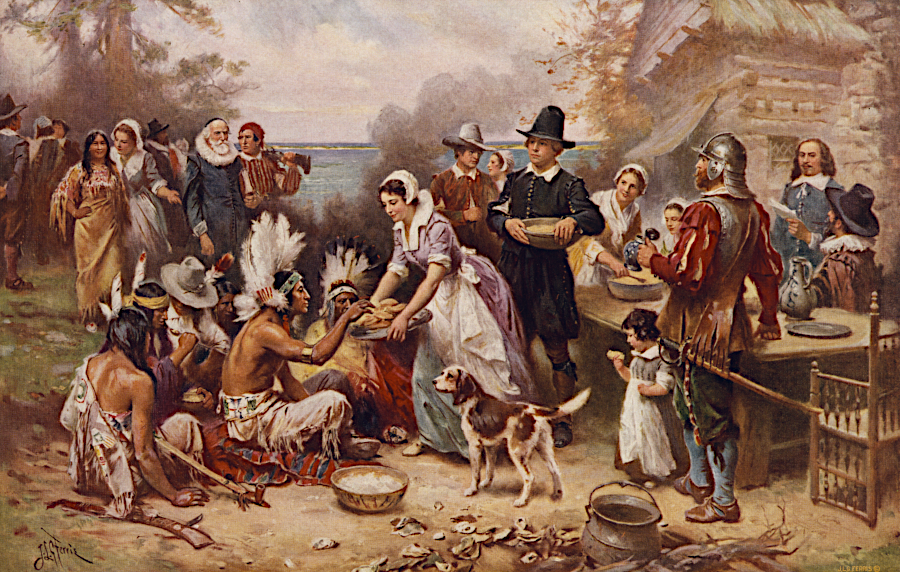
sorting fact from myth regarding religious freedom is as challenging as correcting the story of the "first" Thanksgiving (the Wampanoag in 1621 did not dress like Plains Indians)
Source: Library of Congress, The first Thanksgiving 1621 (by Jean Leon Gerome Ferris, 1912)
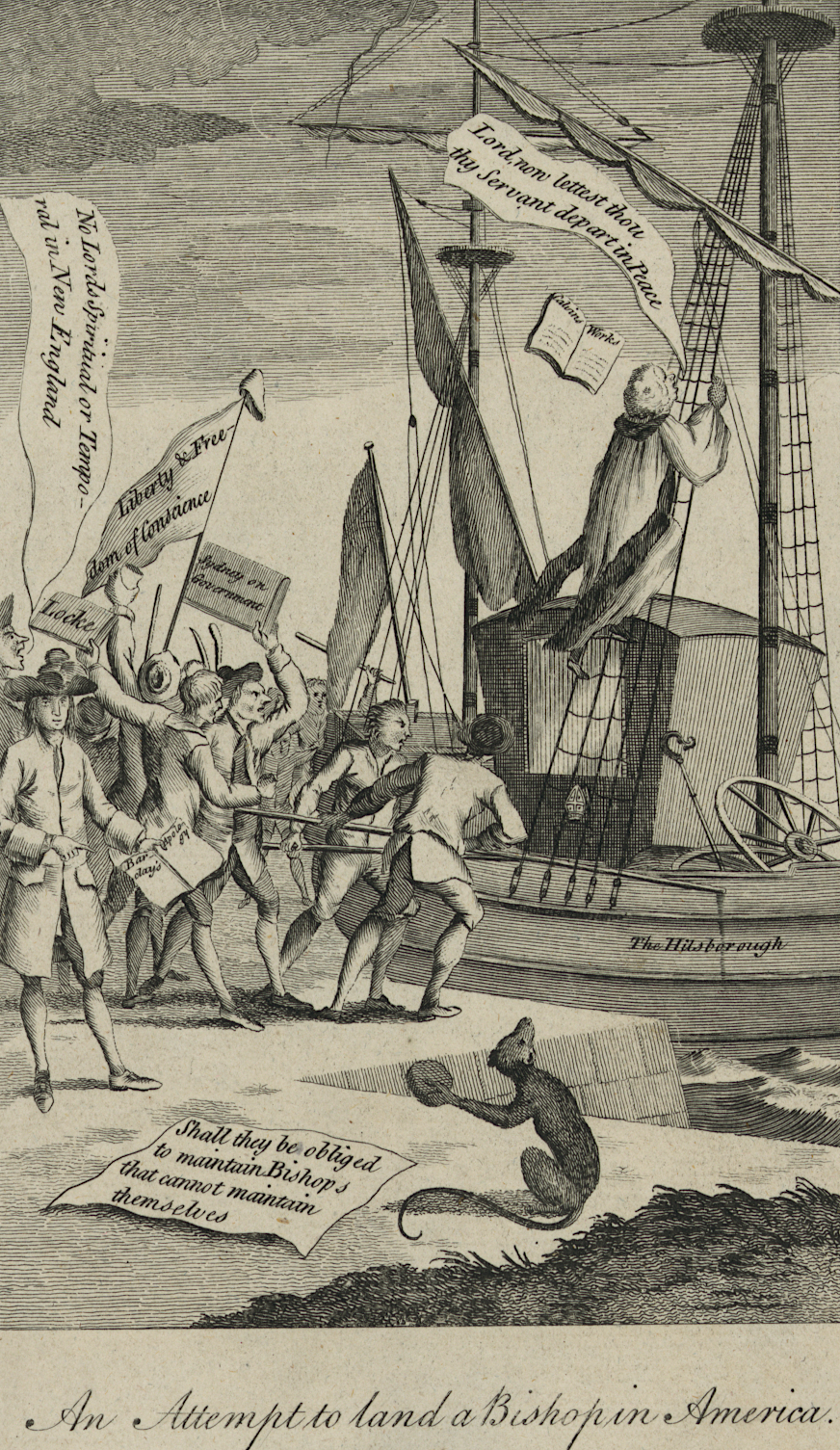
non-Anglicans, especially in New England, feared that an Anglican bishop established in North America would lead to goverment control of religious beliefs
Source: Library of Congress, An attempt to land a bishop in America